OLYMPIC CHEATING
Written by Rick Archer
July 2012
Forward
I have
been a fan of the Olympics ever since I was a boy. There is
something the Olympics that touches me in ways that regular sports
don't. Sure, I love the thrills of watching amazing athletes
perform on a world stage. However, what I love the most is the
sportsmanship.
I love
to see hardened professional athletes walk in the Olympic parade and
see who much the chance to represent their country means to them.
I love to see the athletes join in the center to see the lighting of
the Olympic torch. For the briefest of moments, it seems like
the dream of peace on earth can be a possibility. I love to
see athletes shake hands and show their respect to their
competitors.
Most
of all, I love sportsmanship. As they say, it is not just
about who wins, it is how you play the game. When I cry... and
I cry several times at every Olympics... it is always due to the
sportsmanship.
Unfortunately not everybody embraces the value of sportsmanship.
|
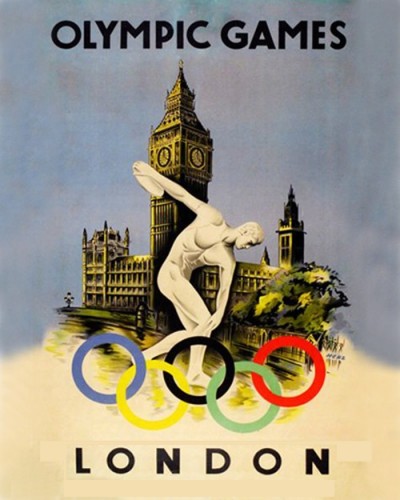 |
There are all kinds of ugly incidents at every Olympics. There are
athletes who win stop at nothing to win. If they aren't good
enough to win outright, then they turn to cheating... the opposite
of sportsmanship.
Cheaters never win, or so
they say. Nonsense. Personally speaking, I think a lot of cheaters win.
With the specter of drugs
tainting baseball, cycling, and track and field, these days we have
become so cynical that we assume practically all winners are under
suspicion.
It really does seem that
ethics in sports and business have fallen to an all-time low. I
noticed a blurb in Time Magazine this week that said “24% of Wall
Street executives say that illegal or unethical conduct may be
necessary to be successful in finance.”
It really does seem that
when the stakes are high enough, some people will cheat. Just
because someone is a world-class athlete doesn’t guarantee the same
person has a well-developed sense of ethics. Their mind-set is
simple. “Do whatever it takes to win.”
With the entire world
watching, every athlete dreams of the glory that comes from claiming
victory for his or her country. Olympic glory carries so much
prestige that the athlete is guaranteed tremendous acclaim that will
stay with them for the rest of their lives.
Considering there are now
7 billion people on the planet, winning Olympic Gold is an
exceptional accomplishment against brutal competition. Often the
margin of victory is ridiculously small. Considering the stakes at
hand and the remote odds of winning, sad to say,
as the following stories will show,some people
are willing to go
to extraordinary lengths to gain any possible advantage.
Professional Athletes attempt to compete against
Amateurs
Almost from the start of
the modern Olympics in 1896, there has been controversy over who is
eligible to compete and who isn’t.
Fueling this debate is
the age-old tradition that only “amateurs” will compete in the
Olympics. This idealistic concept has created a veritable Pandora’s
Box of abuse.
Two of the most famous
athletes in Olympic history fell prey to charges of competing while
“professional”.
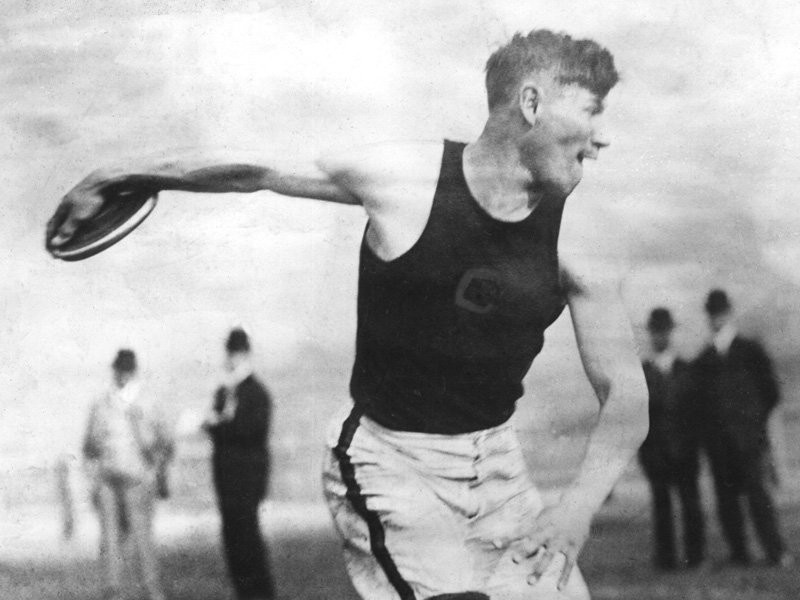 |
Jim Thorpe
Certainly the most famous
story involved America’s Jim Thorpe.
The 1912 Olympics
solidified Thorpe’s reputation as the “Greatest Athlete in the
World”. History has not changed that opinion.
Thorpe dominated his
peers by such a wide margin that he was later named the Greatest
Athlete of the Twentieth Century.
Jim Thorpe completely
dominated the 1912 Olympic Games. Thorpe won Olympic gold medals
for the 1912 pentathlon and decathlon with ridiculous ease.
Both events put a huge
premium on being an all-round athlete and Thorpe definitely fit the
bill. He was the very best at whatever sport he attempted.
Upon giving the medals to
Thorpe at the Games, Sweden’s King Gustav exclaimed, “"You, sir, are
the greatest athlete in the world!" That’s when Thorpe’s fame hit
its pinnacle.
|
Thorpe’s downfall came
shortly after the 1912 Olympics. Rumors abounded that he had played
American football, baseball and basketball for money. These rumors
dogged him wherever he went. There was little doubt the rumors were
true. An Indian by birth, sports were his only skill, his only way
to make money.
Tsk Tsk. Thorpe lost his
Olympic titles after it was found he was paid for playing two
seasons of semi-professional baseball before competing in the
Olympics. Thorpe was guilty of violating the amateurism rules. He
fell victim to the purists.
As a footnote to this
story, in 1983, 30 years after his death, the International Olympic
Committee (IOC) restored all of Thorpe’s Olympic medals.
Paavo Nurmi
Paavo Nurmi was Finland’s
greatest athlete. Known as “the Flying Finn”, during the 1920s,
Nurmi was the best middle and long distance runner in the world. He
set world records at distances between 1500 m and 20 km. Nurmi
astounded the world by winning five gold medals at the Paris 1924
Summer Olympics. This remains today the most track and field gold
medals at one Olympics in the history of the Games. However, Nurmi
could hardly be considered a flash in the pan. Overall, Nurmi won a
total of nine gold and three silver medals in the 12 events in which
he competed at the Olympic Games in 1920, 1924 and 1928.
When the 1932 Olympic
Games rolled around, Nurmi still had enough left in his tank to be
considered a serious medal contender again. Nurmi had set his heart
on ending his career with a gold medal in the marathon event.
The marathon of course
has long been considered the most important distance event of all
thanks to its association with the immortal Greek who ran 26 miles
from Marathon to Athens to report the Greek victory over the
Persians… only to collapse and die.
Unfortunately Nurmi was
branded a professional and barred from running in Los Angeles. The
main instigator of the ban was a Swedish official named Sigfrid
Edström, president of the International Amateur Athletics Federation
and vice-president of the IOC (International Olympic Committee).
Edström claimed that
Nurmi had received too much money for his travel expenses to a meet
in Germany. How picky can you get? This ungallant act was seen as
jealousy by many in Finland. The ensuing bitterness
took a long time to die.
|
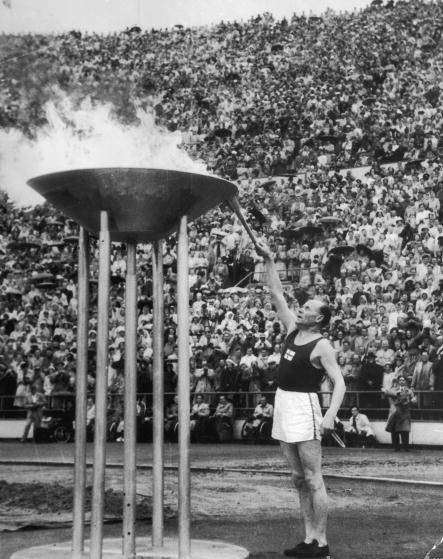 |
At the time, Nurmi
traveled to Los Angeles and kept training at the Olympic Village
hoping they would relent at the last minute. No such luck. Despite
pleas from all the entrants of the marathon, Nurmi was not allowed
to compete at the Games.
Nurmi was bitter. Even
though he had injuries, Nurmi claimed he would have won the marathon
by five minutes.
The
people of Finland were so incensed by the treatment of their
national hero that Finland refused
to participate in the traditional Finland-Sweden international
athletics event again until 1939.
Cold War Olympics
The stories of Thorpe and
Nurmi were to be repeated many times over the years. In
particular, the arguments over the definition of “amateur versus
professional” became especially bitter during the Cold War. The
Soviet bloc exploited this argument to great advantage.
Gifted Russian athletes
were told to report to the Red Army where they could participate in
state-supported year-round training without violating their amateur status. U.S.
officials decried the hypocrisy of this system, but their pleas fell
on deaf ears. The Russians had too many friends in high places to
lose this political tug of war.
No one single event illustrated the American
frustration with Russia’s so-called unethical system more than the
controversial 1972 Olympic Basketball finals.
|
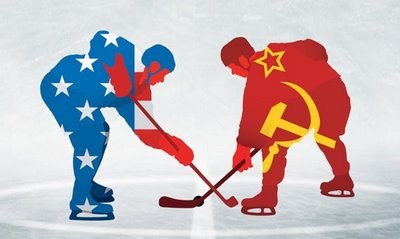 |
a phantom Time-Out Kills the US Basketball Team
|
 |
It was 1972 in
Munich. The U.S. was playing Russia for Olympic gold. It was a
huge showdown. Since Basketball was a game that originated in the
USA, the sport had long been a huge source of pride for America. At
63-0, the United States had never lost a single basketball game in
Olympic competition.
However, by 1972
the gap had finally been closed. The Russians were favored mainly
because it was men against boys. The Russian players were all at
least five to ten years older than their American counterparts.
However, these college kids gave the Russians a heck of a game.
With a group of U.S. collegians playing against the
quasi-professionals on the Russian side, the game was close
nonetheless. This game had turned into a real nail-biter.
With the U.S. team
trailing 49–48 in the waning seconds of the contest, American guard
Doug Collins stole a Soviet pass at half court and was fouled hard
as he drove toward the basket. Collins was knocked nearly senseless
as he was driven into the basket stanchion. Shaking off the blow,
with just three seconds remaining on the game clock, Collins sank
the first free throw to tie the score at 49.
However, just as
Collins lifted the ball to begin his shooting motion while
attempting the second free throw, the horn from the scorer's table
sounded. This was a huge distraction and
very unusual. Horns are not supposed to go off while a player
is in the middle of shooting. It marked the beginning of a
chain of events that would lead to the game's final three seconds
being mired in controversy for eternity.
Although the
officials involved were later said to be merely incompetent rather
than conspiratorial, from this point on it sure seemed like
either the referee or someone at the scorer’s table had
definite Russian sympathies.
|
The unexpected
sound of the horn caused lead referee Renato Righetto to turn away
from the free throw attempt and look over to the scorer's table to
see what the reason was for the horn. However, no whistle was blown
and the play was not stopped. Collins continued with his second
free throw and never broke his shooting motion. The shot rattled
around. Finally to the immense relief of the US fans, the ball
finally dropped through the net.
This score put the
U.S. up by 50–49 with just 3 seconds to play.
It looked to the world like Doug Collin's key steal had rescued the
game for the American side.
Play was
immediately resumed, but nothing of significance happened in the
final 3 seconds. That's it. Game over!
The US began to wildly celebrate their
improbable come-from-behind
50-49 win.
Suddenly to the
USA team’s dismay, the men were stopped mid-celebration and told the
clock had to be reset due to a time-out “not called”. No one
understood what this meant. If it wasn’t called, then so what?
Game over!!
Later testimony
made it seem unlikely that any such time-out had been called.
Nevertheless the officials gave the Russians the benefit of the
doubt.
Naturally the
Americans were furious, but the Russians won the protest.
The last 0:03 seconds would have to be
replayed.
Play resumed, but
when a Soviet long pass went awry and landed out of bounds,
the
buzzer sounded. Game over. Again the Americans jumped
and whooped and hollered...
The American
celebration soon stopped when there
yet was another mysterious horn from the scorer’s table during
the play.
Something was wrong
again.
It seems that someone had re-set the clock was
reset to 00:50, not 00:03 as it should be.
'So what?' the
Americans said.
3 seconds or 50 seconds, what difference
did it make as Russia failed to score?
|
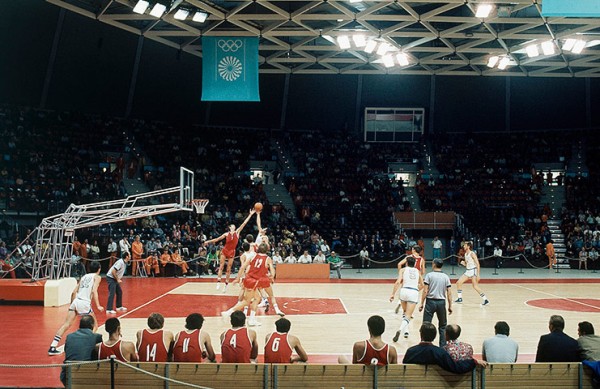 |
The Americans were
told the play didn’t count because the horn had gone off during the
play. The horn went off because someone had
noticed the clock had been
reset improperly. At this point, Dr William
Jones, the British secretary of FIBA, intervened – something the US
team maintained he had no authority to do – and ordered the clock to
be reset to 0:03 and the game restarted. The teams were
told the clock would be reset to three seconds because of an error
in re-starting the clock correctly. What an interesting mistake.
The
Americans were incredulous. They could not believe someone
from a country said to be their ally would stab them in the back
like this. Unfortunately the man was far too powerful.
Nothing could be done to overrule his authority. The Americans
gave up and chose to replay the end of the game for the third time.
Meanwhile, despite
the fact that no "official" time out had ever been called, the
Russians had made an illegal substitution. Smuggling in Ivan Edeshko was a key move.
Edeshko was
one of the two men who had been
trained to execute Russian’s special end of game play.
Edeshko's role was to throw a long
pass for a tall Russian named Alexander Belov. For the past year, Edeshko
and Belov had practiced this play time and again.
This play had
failed moments earlier, but now thanks to the second try, this
time the
well-executed play worked to perfection.
Edeshko threw a
length-of-the-court pass to the giant Soviet player Alexander Belov.
At 7 feet, Belov towered over the two Americans assigned to guard
him. A perfect pass allowed Belov to rise above the smaller men
beside him, catch the ball and lay it into the basket
all in one
motion.
As the ball
dropped through the net at the buzzer, one of the
two smaller Americans watched helplessly as he
lay on the floor. He had fallen
down after bouncing off the giant Belov while competing for the
ball.
It was an
unbelievable finish to the game. Russia
had won 51-50. The
image of the mighty conquering Russian and the helpless American
beneath him was
unforgettable.
|
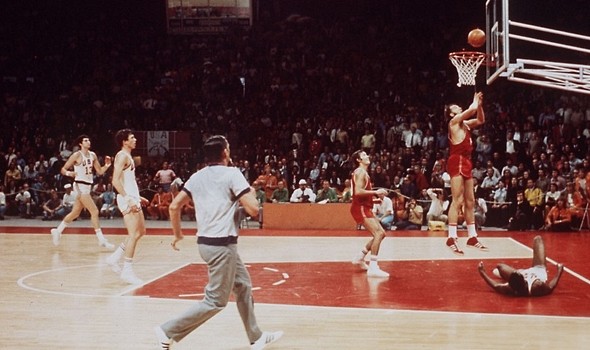 |
Naturally the
Americans protested. They pointed out at least six irregularities
at the end of the game that had all been ruled in the Russian’s
favor. Not one issue had gone the American’s way. They contended
the game should be replayed from the 3 seconds point due to these
irregularities or simply replay the game in its entirety.
Unfortunately, this appeal did little good. The jury was
loaded against the Americans. Of the five people on the panel,
three were from Communist countries. The representatives from Cuba,
Poland and the USSR all voted Soviet. The U.S. appeal was
rejected 3-2.
The U.S. has
forever refused to accept the silver medal.
Taking Another Look at the "Amateur" Issue
Eventually,
however, some good came out of the strange defeat.
Watching massive grown men from the Soviet side
pound against the slender college kids from America throughout the
game plus the strange result garnered sympathy for the Americans
among the neutral countries of the world.
Almost
immediately, there was a definite shift in
attitudes among the Olympic hierarchy
about this “amateur” situation. People
began to agree something was wrong. As the Games
had evolved through the 20th century, the definition of the amateur
athlete as an aristocratic gentleman had clearly
become outdated.
For some
time behind the scenes people had quietly admitted the advent of the
state-sponsored "full-time amateur athlete" of the Eastern Bloc
countries had eroded the ideology of the pure amateur. They
acknowledged this put the self-financed amateurs of the Western
countries at a disadvantage.
The ridiculous
outcome of the 1972 Basketball game served as a
catalyst to embolden people to suggest changes. It stiffened the resolve among many
neutrals to stand up to the Russians and change the rules.
Beginning with the next Olympics,
the amateur requirements began to be gradually phased out of the Olympic
Charter. After the 1988
Games, the IOC decided to make all professional athletes eligible
for the Olympics. Finally the world had a level playing field.
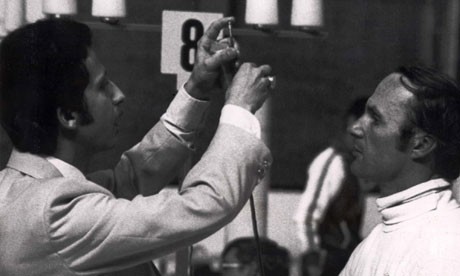 |
The Magic Sword
Throughout the
annals of Olympic cheating, Russia definitely holds the Gold Medal
for suspicious incidents. The 1972 Basketball final is simply
Exhibit #1.
One of the most
blatant acts of cheating in Olympic history
involved a Russian fencer named
Boris Onishchenko
He
was caught cheating by using a doctored
épée during the 1976 Games in Montreal.
Onishchenko, an army officer from Ukraine, was a respected modern
pentathlete who had won a silver medal in Munich four years earlier.
|
The British team,
who went on to win the gold medal in 1976, was the first to suspect
that Onishchenko was up to something. During his bout against Great
Britain’s Adrian Parker, Onishchenko seemed to score at will against
a very good opponent. After Parker lost, he came back to the team
fuming. He was almost positive that Onishchenko had gotten points
without actually touching him. In fact,
Parker said points seemed to be scored even when Onishchenko's
blade had missed by a
considerable distance.
However, these things
had happened so fast
that there was no way to be sure. The
British decided not to say anything.
It was Onishchenko's
bad luck to have another match against an opponent from Great
Britain. In his match against Great Britain’s Jim Fox, the entire
team watched closely. Parker was right. There was something fishy
going on here. Onishchenko’s weapon appeared to register hits
without the foil appearing to touch the other man.
When Jim Fox
protested vehemently to the officials that his opponent was managing
to score without actually hitting him, officials took away the
Soviet athlete's sword and examined it.
Onischenko was
allowed to continue with a replacement weapon, but soon afterwards
the news came through that he had been disqualified. Inspection of
the first épée had revealed hidden wires that allowed the man to register a
hit at will
by means of pulling a hidden trigger.
This trigger
allowed to control the electronic scoring system with his
hand.
Onishchenko exited
the Games in disgrace, with banner headlines around the world
denouncing him as 'Dishonest-shenko' and 'Boris the Cheat'.
Stories that he
was later banished to the Siberian salt mines were probably
exaggerated, but there was no doubt that his deliberate and brazen
attempt to cheat on the world stage humiliated the man for the
remainder of his life.
After reviewing
all the stories, I have decided to give Onischenko the Silver Medal
for Olympic Cheating. It took a lot of imagination and a lot of
guts to try that stunt.
Fred Lorz – the Would-Be Marathon champion
While I give
Russia the overall Team Gold Medal for cheating, Olympic cheating is
not even remotely limited to the Russians. There have been American
scandals too.
The marathon at
the St Louis Olympic Games of 1904 was held over a hilly course in
the middle of a scorching afternoon. Marathon season is generally
in the fall and winter, not the summer. Considering the heat, it
was no wonder that only 14 of the 32 starters made it to the finish.
First home after
three hours 13 minutes, was Fred Lorz, a New Yorker. Lorz was
immediately proclaimed the winner. Lorz was greeted with great
fanfare. Rushing to meet him was Alice Roosevelt, the daughter of
the President of the United States. She
laughed with excitement as she placed a laurel wreath on his head.
Then the two posed for photographs together.
Now it was time to award Lorz the gold
medal. However, the officials were distracted by whispers heard at
the back of the stage.
The ceremony was
put on hold because a
couple of the spectators
in the crowd had recognized Lorz. These people stepped forward to
tell the judges that something fishy was going on.
|
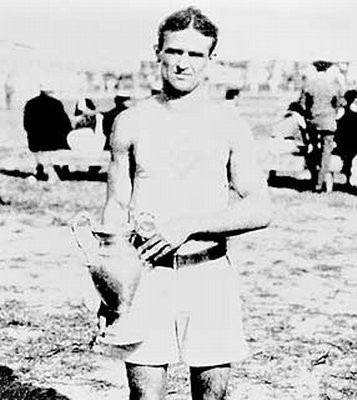 |
The mouths of the officials dropped open with
disbelief. It seemed that
Lorz, exhausted after nine miles of the race,
decided to quit. He
hopped into his manager’s car
that had been trailing the action to get a
breather. As Lorz recovered, his manager resumed following the race
from a discrete distance. This went on for the next 11 miles.
At the twenty-mile, even the car couldn't take it
any more. The vehicle broke down in
the heat. Lorz had no choice but to get
out. Noticing the pack of runners up ahead
weren't that far away, on the spur of the
moment Lorz decided to finish the race with
the other runners. There were six miles
left.
Now that he was
fresh, Lorz moved through the dead-tired pack
of runners easily. Lorz
climbed the ranks at a steady clip. The
crowds cheered and clapped as Lorz amazingly found the strength to
catch and pass the entire field one runner at a time.
The
runners were surprised as he went by. 'Where did this guy come
from?' they thought. 'Haven't seen him the entire race!'
Lorz
completed his thrilling adventure by
crossing the finish line first.
He was mobbed with congratulations. What an exciting finish!
Meanwhile, none of the officials had noticed anything suspicious
because they were concentrating on the front runners. To them,
they were just as impressed as everyone else. It just seemed like
Lorz had staged a magnificent comeback from the rear.
Everyone agreed with the officials. To the casual onlookers,
it seemed like Lorz had pulled off an impressive
“come from behind”
rally. There was certainly no technology in place to check nor was
there any reason to doubt Lorz' credibility. This was back in
the days when cheating was unheard of.
Well,
thanks to Lorz, he was the one who changed all that.
He was nearly
awarded the medal until the spectators brought his cheating to the
attention of the administrators.
Hearing the rumors
of what Lorz had done, the crowd's acclaim rapidly turned to abuse.
Although Lorz claimed it was all just a practical joke, he received
a lifetime ban.
Imagine standing
on the podium prepared to accept the victory award after riding in a
car. How pathetic! I decided to award Lorz the Bronze medal for
cheating.
Why give the Silver to Onishchenko and
the Bronze to Lorz? To my mind, Lorz made a stupid
spur-of-the-moment decision based on the unusual circumstances.
Perhaps if he had given it more thought, he would have come to his
senses. On the other hand, Onishchenko’s move was coldly
premeditated. The Russian truly deserves the Silver.
As an interesting
footnote, after the race, Lorz returned to his career on Wall
Street.
2012: Iranians Set to Compete Against Israeli Jews
This is not a
cheating story, but I can’t help but comment nevertheless.
When it comes to "sportsmanship", I have
never quite figured out why certain Arab athletes refuse to compete
against athletes representing Israel.
Okay, so they don’t like each other, but this usually makes for good
competition. Witness the bloody Olympic water polo match between
Hungary and the Soviet Union in 1956 shortly after the Russians
invaded Hungary. Now that was a brutal game.
You would think
any Arab would appreciate the opportunity to claim victory over an
Israeli in a fair fight on the world stage. That would bring far
more honor to their country as opposed to the cowardly cold-blooded
murder of defenseless Israelis in the 1972 Munich Olympics.
For a moment
there, I thought that in 2012 we were about to make some progress on
this front, but I was wrong.
Bahram Afsharzadeh,
the head of the Iranian Olympic Mission, said on
Monday, July 23, that his
athletes would compete against Israeli athletes in the Games that
start this week.
Now however things
have changed. Despite that statement from the head of the Iranian
Olympic committee asserting that Iranian athletes will compete
against Israelis in the 2012 London Olympic Games, a terrible
last-minute injury now makes any such matchup unlikely to occur.
The Washington
Post reported that when the Iranian team left for London on Sunday,
they departed without judo champion Javad Mahjoob, the only Iranian
athlete who had any possibility to compete against an Israeli.
Ah gee, what a
shame. Don’t you hate those strange last-minute injuries?
Iranian officials
are quoted as saying that Mahjoob is suffering from a “critical
digestive system infection” and will not be able to travel to the
Games. In addition, the official Iranian government Fars news
agency said that the Olympic chairman's words had been taken out of
context. What he meant to say was that Iranian athletes would
compete against all athletes and did not name Israel specifically.
In the meantime,
there are skeptics who suggest that Mahjoob’s sudden ailment is an
excuse to keep him from facing off against Ariel Ze’evi in the
100-kilogram weight class. No, really?
On a historical
note, Iranian athletes withdrew from events against Israelis at the
2004 Athens Games and 2008 Beijing Games. One story in particular
was particularly amusing.
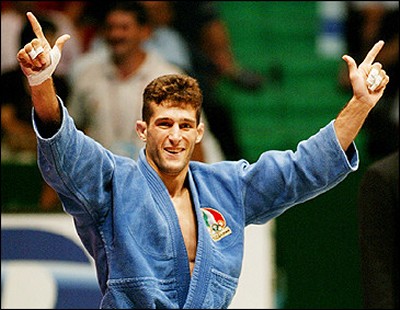 |
In 2004, Iranian
judoist Arash Miresmaili was disqualified after he was found to be
overweight before a judo bout against Israeli Ehud Vaks.
Miresmaili had
gone on an eating binge the night before in a protest against the
IOC's recognition of the state of Israel. The next morning
Miresmaili was too fat to fight.
After this unusual
patriotic gesture, it was reported that Iranian Olympic team
chairman Nassrollah Sajadi had suggested that the Iranian government
should give him $115,000 (the amount he would have received if he
had won the gold medal) as a reward for his actions).
How interesting.
This was surely an Olympic record for most money ever earned by
over-eating! But wait, there’s more.
|
Mohammad Khatami,
then-President of Iran, was reported to have said that Miresmail's
refusal to fight the Israeli would be "recorded in the history of
Iranian glories". Khatami added that the nation of Iran considered
Miresmaili to be "the champion of the 2004 Olympic Games."
Considering
Michael Phelps won 8 gold medals in Athens and Arab runner Hicham El
Guerrouj won gold in both the 1500 m and 5000 m, it is curious that
their accomplishments were overshadowed by the extraordinary
performance of the prolific Iranian overeater.
Could over-eating
perhaps someday become a regular Olympic Sport?
Or at
the very least the thought could surely inspire a wonderful lampoon.
Did any of you
ever see Chris Farley lampoon synchronized swimming on Saturday
Night Live? My gosh, what a Saturday Night Live skit the
“Over-Eating Competition” could be!
Everyone who wants
to watch raise their hand.
BOYS WILL BE BOYS AND BOYS WILL BE GIRLS
Back to cheating,
not eating. One time-honored tradition of Olympic cheating has
certain boys who decide to compete against women instead. There
have been several highly suspicious stories along these lines.
Before the
technology of mandatory drug and gender testing, there were Irina and
Tamara Press. These two Russian sisters were noticeably large and
rather ‘manly’ for being women.
People would say
when it came to throwing the shotput, these girls were almost as
good as the boys.
The Press sisters
were definitely world-beaters. Between them, Irina and Tamara won
five Olympic gold medals and one silver medal at the 1960 games in
Rome and the 1964 games in Tokyo.
As the following
Olympics approached, when an Olympic official had the nerve to ask
the Press sisters to “prove” their femininity, the pair
coincidentally retired on the spot.
What a shame to
see them go at the peak of their careers.
|
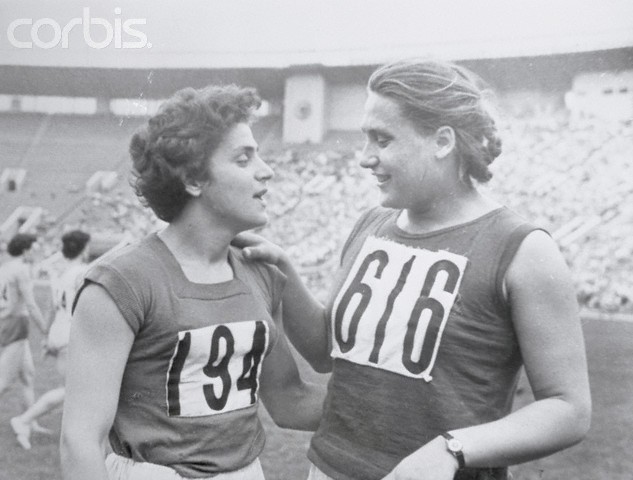 |
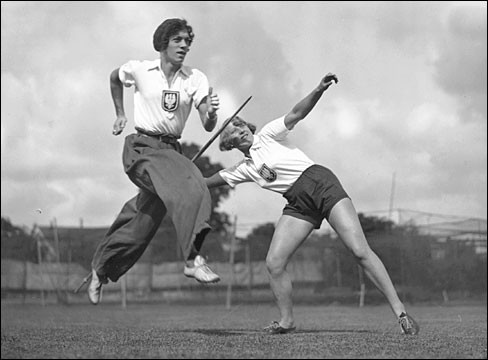 |
Another famous story along these lines was that of Stella Walsh.
Born in Poland in 1911, Stanislawa Walasiewiczowna moved to
Cleveland with her family when she was two. Although Walsh
lived in Cleveland, she represented Poland, her birth nation, at the
1932 and 1936 Olympic Games. Stella Walsh won the gold in the
100-metres in 1932, and took the silver four years later.
In her time,
the Polish-American sprinter Walsh was the
fastest women on the planet. She
set the world record for the 100 meters on 3 different occasions,
earning the title of the "World's Fastest Woman".
Walsh would go on
to set 20 world records. She won 41 AAU titles in events such as
sprints, long jump and discus throw. After her long and illustrious
career, she was inducted into the U.S. Track and Field Hall of Fame
in 1975.
Tragically, five
years later she was shot and killed outside a Cleveland shopping
mall. Police autopsies revealed Walsh had male genitals and both
male and female chromosomes - a condition known as ‘mosaicism’.
Thanks to this bizarre accident, a secret Walsh had managed to
conceal since her childhood was out: Stella should have been named
Stan... or Stella the Fella.
|
Dora Ratjen was a
German athlete who competed in the 1936 Olympics in the High Jump.
This would not be much of a story except for one thing:
Dora was, in fact, actually Hermann Ratjen, a
detail not discovered until after the Second World War, when he was
found working as a waiter -- not a waitress -- in Hamburg.
Hermann was a very
slender man who was coerced by the leaders of the Hitler Youth into tightly binding
his genitals and competing against women. The German Olympic team
had struggled in the previous Olympic Games. So it was thought
entering a man here and there on the women’s side of things might
remedy the situation.
Ah, don’t you love that
constant need to prove Aryan Superiority?
But in the end, the joke was on them and so were their theories of Aryan
superiority.
Ratjen finished fourth, behind three actual women.
|
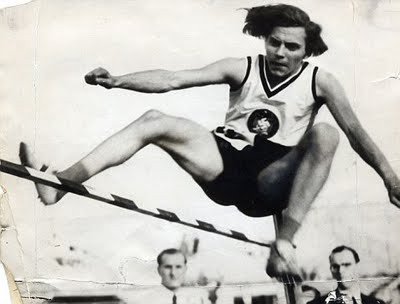 |
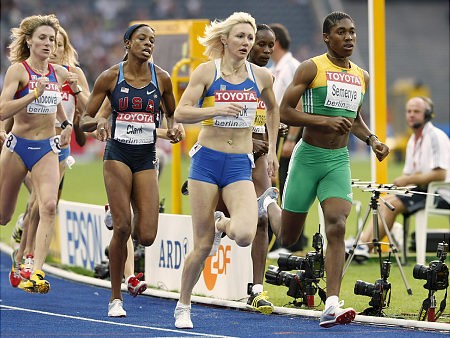 |
There have been
other odd tales over the years. As sex changes become more
prevalent, the question of who is a boy and who
is a girl is one issue that has taken on more and more
controversy.
As
you can see in the picture, Caster Semenya has the physique of a
football running back. victory in the women’s 800 meters at the 2009 World Championships
raised serious questions.
The South African
runner’s sex became a question mark amid
understandable speculation regarding her
masculine-looking physique. She wasn’t allowed to compete for almost
a year. Then she was reinstated without a clear explanation.
You should get to see
Semenya at the London Olympics. He/she is slated to run.
I have to be honest; I
agree with the skeptics. Semenya has rather impressive arm muscles for a
girl. Maybe too impressive.
I expect to hear more
about this story.
|
THE
TEAM SILVER MEDAL FOR AN ENTIRE COUNTRY CHEATING GOES TO SPAIN
|
In its Cold War
prime, Russia elevated Olympic cheating to an art form, but one year
Spain did something far more shameful
than Russia could ever conceive.
Talk about sinking
to new depths in order to reach the top of the podium.
What the Spanish team did was a disgrace to
humanity - they cheated in the Paralympics. Spain was willing
to cheat to beat handicapped athletes!!
The Paralympics is
a noble endeavor that allows handicapped people a chance to compete.
What a wonderful idea, one that is quite in keeping with the Olympic
spirit. The Paralympics has grown to become a major
international multi-sport event where athletes with a physical
disability compete. This includes athletes with mobility
disabilities, amputations, blindness, and cerebral palsy.
In 2000, the
Spanish intellectually-disabled basketball team captured gold at the
Sydney Paralympics with a stellar performance on the court.
|
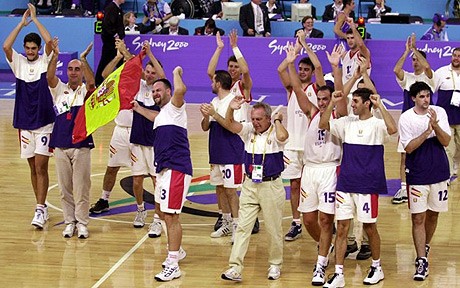 |
But the glory
quickly
faded when the Spanish Paralympic Committee later discovered
evidence that 10 of the 12 team members had no mental deficiency
whatsover.
Following a tip
from one of the Spanish basketball players who was revolted by what
had happened, Carlos Ribagorda, an undercover journalist, revealed
that the players on Spain’s team had not actually undergone the
testing required to prove mental deficiency. It turned out that ten
of the twelve players on the Spain basketball team were perfectly
normal.
It wasn’t just the
basketball team either. Participants in table tennis, track and
field, and swimming events were also not disabled.
Gee, what a thrill
it must have been to fake being a moron so they could defeat a bunch
of legitimate handicapped people on the basketball court. So who’s
the real moron here?
This makes us all
really wonder about Spain a little bit. It isn’t like Spain has a
losing tradition and is badly in need of respect. On the contrary,
for the past decade Spain
has enjoyed one of the finest streaks of sports success in the
world. Soccer, basketball, tennis… Spain is a world leader in many
sports.
So, really, now,
what would possess someone to cheat in the Paralympics? Is the
prestige really worth going to these lengths? I’m not sure it gets
a lot worse than that. When it comes to
poor sportsmanship, this is perhaps the most pathetic story I have
ever heard short of Tonya Harding.
Personally, I
would allow the director of the Spanish team who came up with this
stunt to compete in the intellectually-disabled category without
hesitation. After all, by definition, that man had to have been a
complete idiot.
 |
THE
SUSPICIOUS CASE OF THE TINY TUMBLERS
The young ladies …
or should we say ‘toddlers’? ... of the Chinese Women’s Gymnastics
team were the breakout stars of the 2008 Beijing Olympics. They
held off a serious challenge from the U.S. Women’s team to narrowly
win the team Gold Medal.
However, their
victory became the biggest scandal of the 2008 Games because the
experts all agreed the Chinese were using underage gymnasts.
Women’s Gymnastics
is a weird sport. Being “young” is not a disadvantage when it comes
to women’s gymnastics because this sport favors flexibility over
strength. Just like basketball is the refuge for overgrown
athletes, women’s gymnastics favors tiny little urchins whose
backbones have not yet solidified.
|
What began as
whispers among the media and gymnastics insiders about the ages of
three of China's female Olympic gymnasts -- Jiang Yuyuan, Yang Yilin
and He Kexin (pictured middle) --
grew into ear-shattering, head-hurting shouts after the Olympics
concluded.
Despite assurances
by Chinese officials that all three were 16, the minimum age of
eligibility for Olympic competition, newly discovered documents and
records would prove otherwise.
The New York Times
first looked into the age of China's gymnasts with a story that
focused primarily on He Kexin, the gold medal winner on the uneven
bars. Her birth date on numerous online records was listed as
January 1, 1994. 2008 minus 1994 equals 14.
If these records
were correct, He Kexin was 14 when the Games began and therefore
ineligible to compete.
When the world was
officially introduced to He Kexin, even those unwise to the ways of
competitive gymnastics could tell that something was not right with
the girl. At 4-foot 8-inches tall and weighing 72 pounds, the
Beijing native appeared significantly younger than most of her
Chinese teammates and younger than her American and European
counterparts as well.
|
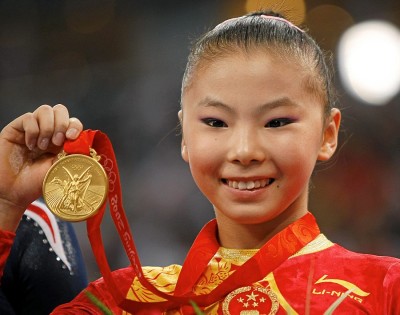 |
Bela Karolyi, the
world's foremost expert on female gymnasts, routinely referred to
the 2008 Chinese team as "half people" in his role as commentator to
NBC during the Olympics. Practically every night Karolyi would
rail against the Chinese for engaging in age falsification.
After China barely
outscored the U.S. in the qualification round, Karolyi had this to
say about the Chinese gymnastics officials:
“These people think we are stupid...We
are in the business of gymnastics. We know what a kid of 14 or 15 or
16 looks like. What kind of slap in the face is this? They are 13,
14 years old and they get lined up and the government backs them and
the federation runs away and hides. There is an age limit and it
can't be controlled.”
However, when
confronted with the incriminating documents, the Chinese Olympic officials would
not back down. They forcefully defended He Kexin's eligibility.
They
maintained that when asked, they submitted proper passport
documentation to the IOC.
He
Kexin's passport says her date of birth is
January 1, 1992, making her 16 and old enough to compete. However, as
Karoyli told the AP, "passports mean nothing."
The 2008 problems
were nothing new. China has a rich history of age falsification in
Olympics competition. At the 2000 Sydney Olympics, three years
after the minimum age was raised to 16 in gymnastics, Chinese
gymnast Yang Yun competed and won a bronze medal in the uneven
bars. Apparently the uneven bars favor the flexibility of youth.
Yang's passport said she was born on December 24, 1984 and turning
16 in the year of the Games, making her eligible. However, Yang
later confessed in a television interview that she was only 14 at
the time of the competition and that she and her coaches had lied
about her age.
As in the case of
Yang Yun, the existing records prior to the Olympics -- local
registries, athletic records and news articles -- were all correct,
whereas the documentation she showed Olympic officials to confirm
her eligibility proved to be false. It is no coincidence that He
Kexin's passport was issued on February 14, 2008, a mere 6 months
before the Olympics.
What did the IOC
have to say about the scandal? President Jacques Rogge said, "The
IOC relies on the international federations, who are exclusively
responsible for the eligibility of athletes. It's not the task of
the IOC to check every one of the 10,000 athletes."
Rogge is correct
that the IOC need not check everyone. However, when you receive a
complaint about an athlete who hasn’t even reached puberty, it
wouldn’t hurt to check out two or three in the interest of fairness,
especially the ones who look like they're ten.
It is
really pathetic when the second place finisher looks old enough to
be the winner's babysitter.
|
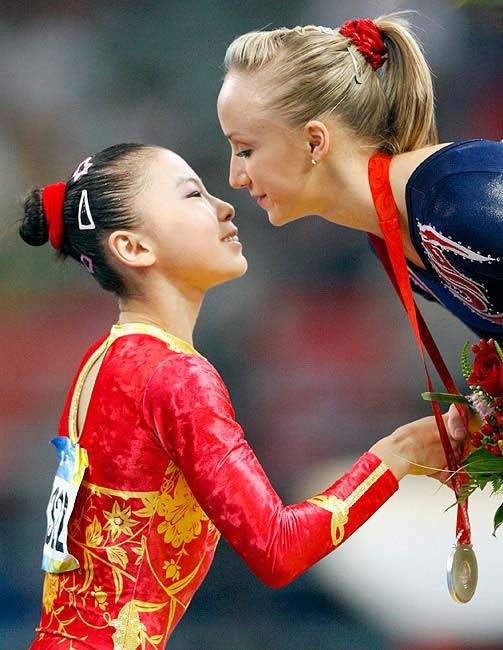 |
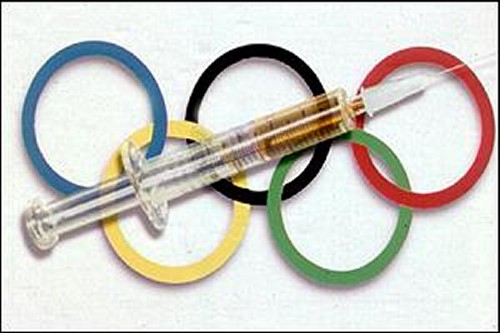 |
DRUGS!!
Victory through
enhanced chemistry! Just don't get caught.
Bending
or breaking the rules of competition has been around as long as
sport itself. Finding a way to
win can tempt an athlete to test the boundaries of fair play, as the
difference between fortune and failure is using
measured in fractions of a
second.
Most
people don't cheat because there are eyes and cameras everywhere.
But what if there was an invisible and quite effective way to cheat?
When it comes to
the idea of cheating in the Olympics, most people immediately think of
drug-assisted victories. Since the margin of victory is often
infinitesimally small and the rewards so dramatically high, there is
an overwhelmingly temptation for good athletes who don’t wish to
settle for being “good” to turn to drugs to boost performance.
|
Cheating
by drug use is not considered a big factor
in certain sports like shooting, archery, basketball, freestyle
skiing and curling. These sports are examples where skill far
outweighs strength or lung power.
However in the
endurance sports like speed skating, track and field events,
cross-country skiing and biathlon, there's a dark history of
skullduggery through drug use.
Whether it's a
deliberate shot in the arm or an innocent “cold pill” here and
there, the temptation to use drugs
and become famous must be
a terrible temptation. The problem for many athletes is that
sports are their way of making a living. Today's drugs are so
powerful that they give a tremendous advantage to an athlete.
Countless stories abound of athletes who were once "average"
suddenly beating world-class athletes. This in turn puts
tremendous pressure on all the other athletes who note with extreme
bitterness that they may be forced to dope as well or never win
again.
Doping and steroid
use is in the public spotlight today thanks to a nasty trend of
medical people who try to win one for the team through better
chemistry. This in turn has given rise to squads of ‘good guy’
medical experts who scrutinize urine samples and blood samples to
look for suspicious spikes in the oxygen content of red blood cells.
Doping has become
a major part of the Olympics. And now that it is clear that the
winners are often also cheaters, “Testing” has become just as
important.
Knud Jensen
The first doping
scandal took place at the 1960 games in Rome. That is when Danish
cyclist Knud Enemark Jensen died after being given amphetamines and
Roniacol before his race.
Jensen collapsed
during his Olympic event, fractured his skull, and was pronounced
dead in a nearby Rome hospital shortly thereafter. The autopsy
showed he had taken amphetamines and Roniacol. This is a
direct-acting peripheral vasodilator that causes flushing and may
decrease blood pressure. The drug was meant to increase blood
circulation.
Jensen was also
reported as swallowing eight pills of phenylisopropylamine and
fifteen pills of amphetamine and coffee.
However, in a
strange twist, on March 24, 1961, the three physicians who performed
the autopsy submitted a final report stating that the death was
caused by a heat wave, not by the drugs found in his body.
His family
received one million lire ($1600 dollars) in compensation for his
death.
This compensation scenario seems
strange because none of the other competitors fainted. It seems
suspicious that the only one who fainted was the one with 25 pills
in his system.
The Narrow Edge of Victory
In Olympic ski
races, the top 30 contenders can be within 60 seconds of one another
over 15 kilometers. With such a narrow margin separating the top
from the bottom, the temptation to use erythropoietin (EPO) is huge.
EPO is a
genetically engineered version of a natural hormone made by the
kidney. EPO stimulates bone marrow to make red blood cells. It
started to emerge in the Salt Lake City Olympics in 2002.
Jim Stray-Gunnersen,
a U.S. physician who helped develop blood-doping testing programs in
the 1990s, says effective blood-doping can take endurance athletes
from 30th place all the way to the podium.
Canadian Pierre
Harvey, a cross-country skiing star of the 1980s, tells a
fascinating anecdote. To this day, he recalls how Russians who he
could defeat soundly before and after the Olympics suddenly surged
past him when it really counted at the Calgary Winter Olympics in
1988.
"When I see four
Russians finish in the top six at the Olympics, it's just not
normal," said Harvey. "In the next weeks following the 1988 Games, I
won several World Cups, but in the Olympics, I was merely 14th."
At the time, Harvey suspected the
athletes were using blood doping, where they transfused higher
oxygen content blood into their bodies several weeks before a key
competition.
Michelle Smith - Poster Girl for Getting Away With It
Michelle Smith
was an Irish swimmer who was a triple gold medalist at the
1996 Summer Olympics in Atlanta. She won the 400m individual
medley, 400m freestyle and 200m individual medley. She also
won the bronze medal for the 200m butterfly event for good
measure.
Significant
controversy followed one of those victories when celebrated
U.S. swimmer Janet Evans accused Smith of doping at a press
conference. Evans, a highly-respected athlete, was incensed.
She immediately claimed Smith's unexpected victories could
only be explained by one thing - Drugs.
Those
accusations were never proven. However, the facts
surrounding the situation supports Evans' claims. No
Irish swimmer had ever won an Olympic medal until Smith came
along and Smith's previous Olympic record had been
"mediocre".
Suspicions about
her suddenly improving performances at an age considered to
be late in a swimmer's career had been raised earlier after
her medal wins at the 1995 European Championships.
Moreover, Smith was viewed upon with suspicions thanks to
guilt by association. Her husband and coach, Erik de
Bruin, a Dutch discus and shot put thrower, had failed a
drug test in 1993 and had been suspended from competition.
As it turned
out, Smith should have quit while she was ahead. Smith
received a four-year suspension in 1998 after being found
guilty of tampering with a urine sample.
|
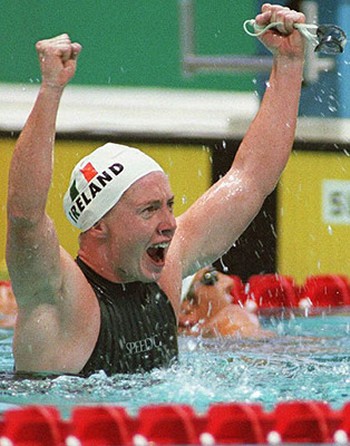 |
The ban was imposed after a urine sample taken during a
routine random drug test was found to be contaminated with
alcohol, a masking agent. On closer inspection, the
bodybuilding drug Androstenedione was found in her samples.
On an
interesting note, Smith
was not stripped of her Olympic medals from Atlanta.,
because her doping offense was detected sometime after the
games. At the time, she was single-handedly
responsible for Ireland's second-largest ever medal haul at
one Olympics.
Thus,
she remains Ireland's most successful Olympian ever.
People often
point to Smith to build their case for "retroactive
disqualification". The problem is that it is far too
easy to mask drug use at the time it is occurring.
Increasingly, the drug cheats are not caught till years
later thanks to improvements in testing.
People say that
anyone who is caught at any point in their career should
lose all credibility and their medals as well.
"Once a cheat,
always a cheat".
|
Shiwen Ye - The Newest Michelle Smith?
The first
"cheating" controversy of the 2012 London Games involved a
record-setting teenager who put up times that surpassed the
times of the current world's fastest MALE swimmer.
Shiwen Ye of
China stunned world swimming by winning gold in the 400m
individual medley in a world-record time. It was her final
100m of freestyle, in which she recorded a split time of
58.68sec, that aroused suspicion. Over the last 50m of the
race she was quicker than the Ryan Lochte, who won the men's
400m individual medley in the second-fastest time in
history.
So how does a
teenage girl manage to swim faster than the world's fastest
man? A lot of people are asking that exact question.
|
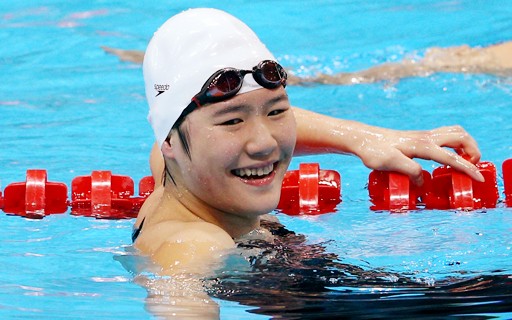 |
Interestingly
enough, Shiwen Ye has people invoking the name of Michelle
Smith.
John Leonard, an
American who is the executive director of the World Swimming
Coaches Association, said the 16-year-old's performance was
"suspicious". He said it brought back "a lot of awful
memories" of the Irish swimmer Michelle Smith's race in the
same event at the Atlanta Olympics in 1996. Smith, a
relative unknown, burst on the scene at the 1996 in a blaze
of glory winning race after race amid a wave of accusations
and suspicions. To everyone's delight, Smith failed a
drug test just two years after the Atlanta Olympics when she
tested positive for an anabolic steroid in 1998. So is
Shiwen Ye the new Michelle Smith?
Ye's time in her
final 100 was nearly a dead heat with Lochte's final 100.
How does a 16-year-old girl keep pace with a 27-year-old man
on a night he is acclaimed as best male swimmer in the
world?
Swimming World columnist John Lohn had this to say:
"When it
comes to doping and allegations of drug use, China
hasn't done itself any favors. Its track record opens
itself up — to a degree — to a level of doubt. Such is
the way things go when a country has been cited for a
systematic doping program, which was in effect in the
early 1990s.
Remember, the Chinese women won 12 of 16 gold medals at
the 1994 World Championships under a cloud of suspicion.
Still, the accusations fired at Ye are out of line in
this age of drug testing. Instead of dirtying her
achievement with unfounded claims and doubts, it would
be wiser to appreciate a performance which was legendary
and put a check mark next to her name."
|
Masking Steroid
Use
Let's not be naive here.
Steroid
use has become a major part of many different sports.
The story of Michelle Smith
is just the tip of the iceberg. As the story of China's
"unusual" swimming success suggests, it is very difficult to catch
the drug cheats. The main reason for this is the ability to
disguise an athlete's drug use, a process known as "masking".
Here's a simple example of
masking taken from the Internet. You have my word that I did
not make this stuff up.
Q - "Can anyone shed
any light on drug testing for steroids? Also if possible, is
there any way to "mask" or cleanse your body to pass a test?
Kind of like the cleansing teas for pot-smokers. This is
very important so any help would be greatly appreciated."
(posted 27-Jul-2002, 06:08 PM)
A1 - "Hey bro I bought one from Kokopelli & Spike called steroid
cleanse. I am an NCAA athlete and have it on hand just in case
those jerkoffs try making me. They give you something like 48
hours and it supposedly this works in 48 hours. Product is
called steroid cleanse. I haven't used it but I have it on hand
just in case. Hope this helps.
(posted 27-Jul-2002, 06:26 PM)
A2 - "If you talking about NCAA then they look at test/epitest
ratios. If that is the case you can add epitestosterone to the
mix.
If it's the Olympics
they test for metabolites of chemicals.
If you try drink a lot
of water to dilute, be sure to add in cranberry juice to adjust
ph. NCAA also tests for epitestosterone and metabolites.
Trust me on this one. The odds are definitely in your favor.
Most probation officers do not even know that their little $6
test does not test for anabolics. Most likely you will only be
tested for street drugs.
You have several things in your advantage here. Remember
that they test lots of people and rarely run any sophisticated
tests unless some marker shows up. You just need to get
smarter than they are and you will be fine.
Tell us your steroid use when you got caught and when you got
caught.
For example if you were caught with Deca-Durabolin - nandrolone
decanoate - than those metabolites can hang around for 18 months
- so you could essentially test positive on the drug test but
your argument would be that you tested positive b/c you were on
Deca-Durabolin - nandrolone decanoate - when you got caught.
Metabolites stick in your system for up to 18 months depending
on the type. Also if you are having a generic urinalysis, they
don't even test for anabolics. I work in a medical lab and do
these tests all the time. I have been doing these tests for 6
years and have never, NEVER seen a test for anabolics. Drugs of
abuse, yes, but never anabolics.
Give us some details of your situation, why you are being
tested, what you have taken, your stats, etc... and then we can
go from there. If you don't feel comfortable posting it, shoot
me an email. Give us all of your details - this one will
be fun.
(posted Jul-2002, 06:29 PM)
 |
So that raises the question. Just how hard is it to beat
the drug tests?
The
answer will vary depending on who you ask that question to, but apparently it is not that hard to beat the tests most of the time.
Here's why.
The trainer has
a huge
advantage because he goes first. A trainer will give an
athlete an injection of steroids. Then the trainer will draw
blood and urine. At this point the trainer will analyze the
results just like a lab would. The trainer sees what shows up
on the Toxicology screen. The problems are clear to him.
At this point,
the trainer goes about finding
a way to mask the results. If
the trainer has a brain, he won't let the athlete be tested outside
the clinic until he
has found a way to disguise the drug use well ahead of time. Once his own results no longer show drug use, the athlete
is probably safe from detection.
|
At this point in time, the
athletes and the trainers seem to have a strong upper hand. The drug
testers are playing "Black" in chess. They are often
being asked to detect drugs that have never even been seen before.
However the testing
agencies have one very potent advantage - they get to keep frozen
blood samples for eight years. Since new tests are
being developed all the time, four years from now the testing might
begin to detect what was fashionable four years earlier.
As the tests grow more
sophisticated, the labs have the right to go back and test the blood again
whenever they want to.
There's always the chance something will pop up. This has a
real chance of working because the trainer who develops masking
techniques today has no idea what
tactics might be used four or five years in the future.
Coincidentally, at this
very moment Lance Armstrong is being sued again. It seems that a
very old blood sample has come up positive thanks to retesting using
new techniques. Now Armstrong is back in court forced to
fight the same old battle for the umpteenth time.
The stakes are high.
They are trying to strip Armstrong of all his Tour de France
victories. This possibility of "retroactive
disqualification" has to strike terror in every person's heart who
has ever used drugs to attain a victory.
This raises the bizarre
specter that someday in the future, Gold Medals will not be handed out till
8 years after the race was run.
|
East Germany
Before there was China, there was East Germany. The case for "retroactive disqualification" is
further bolstered by the farce of the East German spots machine. Russia and China
have long been accused of doping their athletes.
However, East Germany wrote the book. Their flagrant use of
steroids makes the Russians and Chinese seem like
amateurs.
Throughout the Fifties and Sixties following the war, East
Germany accomplished little in the Olympics. Then
the East Germans suddenly
became a sporting powerhouse in the 70s and 80s.
Practically overnight, the East German athletes were now the
equal of the much larger United States and Soviet Union. Pretty
impressive considering the East German population was at best 1/20th
the size of their larger rivals.
In 1976, 1980, and 1988
(they skipped 84),
East Germany came in second in the
Summer Olympics
just behind the Soviet Union and well ahead of larger West Germany.
Apparently all the German ubermenches must have
gotten stuck on the East German
side at the conclusion of World War II.
East Germany’s
performance was even better at the Winter Games. Over a span of
five winter games, East Germany had four second place rankings and a
first in the 1984 Winter Olympics.
East Germany won 20 Gold Medals in 1972. East
Germany won 40 Gold Medals in 1976. So how does a
country of fewer than 17 million people manage to double its Olympic
output from 20 to 40 gold medals in just four years? Drugs, and
plenty of them!
|
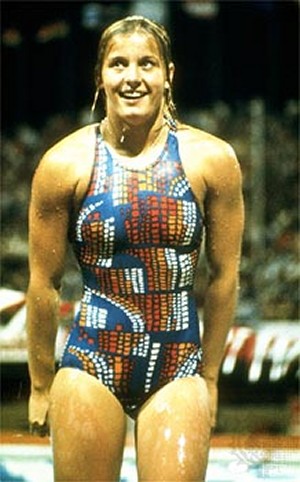 |
It is widely
believed that doping (predominantly anabolic steroids) allowed East
Germany, with its small population, to become a world
sports leader in those
two decades.
Here's another statistic. In 1988, at the peak of the East German
sports machine, East Germany won 102 medals with 17 million people.
The USA won 94 medals with a population of 240 million.
Considering the United States is consider the world's superpower
when it comes to athletics, you have to wonder how on earth the East
Germans got away with so much cheating.
There are reports
that thousands of East German athletes were given
performance-enhancing steroids in an effort to prove East German
superiority over the West. Many of the athletes
later claimed the officials told them they were
simply taking ‘special’ vitamins.
Special indeed! These
'vitamins' worked miracles. East Germans became a mighty force in amateur
sport, particularly in the swimming pool where
the results of the wonder vitamins were especially spectacular.
But with the
medals and titles came serious negative health side effects, such as
hormonal changes and organ damage. Steroid
use is dangerous. It can do serious damage to the heart and to the
liver. The women athletes in
particular suffered many health problems in later years.
Throughout the Eighties, everyone was pretty sure what was going on
in East Germany, but they couldn't catch them.
The worst thing to
ever happen to East Germany was the fall of the Berlin Wall. As the
Wall fell, so the veil of secrecy surrounding the East German sports
success. Although many documents showing
the East German drug use were destroyed, the practice was so
wide-spread that evidence kept popping up everywhere. The
world gasped when they realized the extent of the doping that had
gone on behind the Iron Curtain.
In the Nineties, a German court found
ex-East German sports boss Manfred Ewald and his medical director,
Manfred Hoeppner, culpable for what it called "systematic and
overall doping in East German competitive sports" until the fall of
the Berlin Wall in 1989.
Marita Koch
The story of Marita Koch
is a good
example of what was discovered once East German records were
analyzed. Marita Koch is a former sprint track and field
athlete who was part of the amazing East German sports machine back
in the Seventies and Eighties.
Before retiring
in 1987, Marita Koch won the
European Championships at 400 meters in 1978, 1982 and 1986.
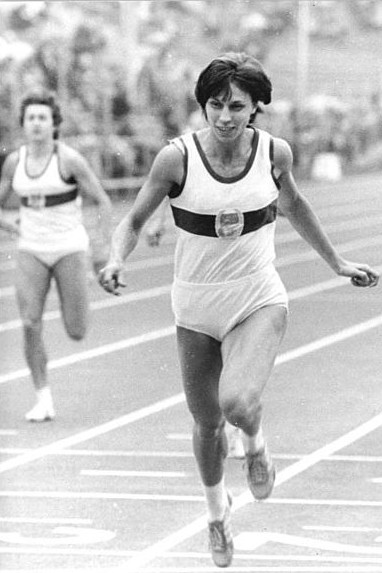 |
She was one of Germany's most successful
athletes.
During her career,
Koch collected
a remarkable 16 world records in outdoor sprints and 14
world records in indoor events.
Marita Koch
never failed a drug test nor did she ever acknowledge any
taint.
Koch insisted: "At the World Championships in
Helsinki in 1983 I had to go to dope-testing three times and
always I was clean. The same applies to my career overall. I
was a mature and responsible athlete."
Ordinarily we
would clap in recognition of her remarkable achievements and
move on to the next subject. However, there's more to
the story (that seems common with drug users).
After East
Germany fell, Koch's achievements, along with the
extraordinary performances of many other East German female
athletes, came under scrutiny. Her
success had aroused suspicion that they were achieved with the
aid of performance-enhancing drugs that
were not detectable at
the time.
In 1991 German anti-drug activists Brigitte Berendonk and Werner Franke were able to save several
doctoral theses and other documents written by scientists
working for the East German drug research program.
Apparently someone forgot to
destroy them.
The documents listed the dosage and
timetables for the administration of anabolic steroids to
many athletes of the former GDR, one of them being Marita
Koch. According to the sources, Koch used the anabolic
steroid Oral-Turinabol from 1981 to 1984 with dosages
ranging from 530 to 1460 mg/year.
Koch refused to publicly admit to
this. However, a letter
written by Marita Koch
to the head of the state-owned
pharmaceutical company was discovered by researcher Werner
Franke. In the letter, Koch complained
because she believed
her teammate Bärbel Wöckel was
receiving larger doses of
steroids thanks to a relative working in the company.
Busted.
|
The
Chinese Women's Swimming Program
There was a
rumor that after the fall of Berlin Wall in 1989, several of
the East German doctors reappeared in China.
Interestingly, it was right about that time that China's
women swimmers began to win big. Coincidence?
Probably not.
At the 1992
Barcelona Olympics, the Chinese women had a very strong
showing. They won gold in 4 of the 15 events.
That was just a hint of things to come. 1994 was the
blockbuster year. At the 1994 World Aquatic
Championships in Rome, China won an amazing 12 of 16 events.
|
The leader of
the Red Tsunami was a tall woman named Le Jingyi (pictured)
with a ripped body. With her powerful 6' 1'' frame,
muscular shoulders and preposterously narrow waist, this
woman had a tapered physique more commonly associated with a
male college football linebacker.
After sweeping
practically every event in 1994, two years later at the 1996
Atlanta Olympics, the Chinese women won just one swimming
event. Le Jingyi, the world famous swimmer, rescued
Chinese honor with the single victory in the 100m Freestyle
event.
From 12
victories to just one was quite a change. After her
victory, Le Jingyi was asked a very curious question.
"Why it is that China's swimmers instantly became world
beaters in 1994 and have just as quickly disappeared from
the winner's podium?"
Le Jingyi
(translated): "I think it
is because the champions retired immediately after they
won a gold medal, we all did. The athletes after us are
not as good as us."
That is an
interesting explanation, but there might be another
explanation that makes more sense. Maybe the Chinese
stopped using the steroids because they knew the drug
testing at the Atlanta Olympics would be unbelievably
rigorous. Being caught on the world stage was too big
a risk.
The Nineties
were a decade of shame for China. After that sweep in
Rome, seven Chinese swimmers tested positive for steroids at
the Hiroshima 1994 Asian Games held just one month after
Rome. How pathetic. Nor was this just a random event.
A sports scientist at San Diego State tallied 32 Chinese
swimmers caught for drug offenses in the 1990s. Two of them
were caught twice.
It is said that
China's bid for the 2008 Beijing Olympic Games forced the
country to behave. China vowed to establish a
world-recognized anti-doping program. However there
have been further incidents that suggest the drug practice
continues to this day. In addition to the earlier
story about Shiwen Ye at the 2012 London Games, here are two
other stories written in 2012 about the issue.
|
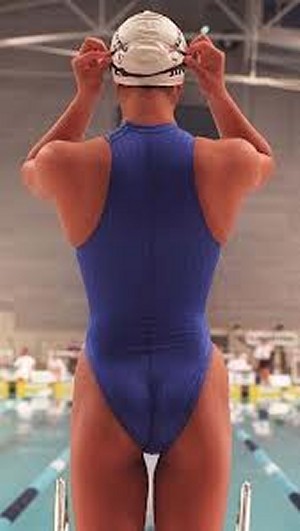 |
| |
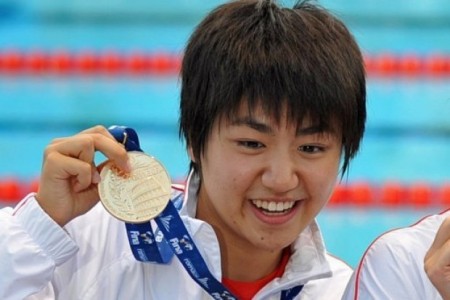 |
China's Li Zhesi fails doping test
Updated: June 9, 2012, 12:04 PM ET
Associated Press
BEIJING -- The Associated Press is
reporting that Chinese swimmer Li Zhesi tested
positive for EPO in March 2012.
The
official Xinhua News Agency, the Chinese state
media, says swimmer Li Zhesi who was part of the
country's winning team at the 2009 world
championships has tested positive for doping. The
16-year-old Li Zhesi tested positive for a
performance-enhancing drug EPO in March.
This is
a major announcement for the Chinese team. China has
spent the past decade rebuilding its swimming
program following a series of doping scandals that
devastated the sport in 1990s.
|
The 16-year old Zhesi was the 2010 Asian Games
Champion in the 50 free (at only 14 years old) and
also anchored the Chinese medley relay that won the
2009 World Championships that is the current World
Record holder. In 2011, she anchored the prelims
round of the silver-medal relay in the same
event.EPO is a hormone that boosts the body's
production of red blood cells.
EPO is a
substance that occurs naturally in the body, and
controls red blood cell production. But an excess of
EPO, used artificially, can severely ramp up red
blood cell production, which in turn can take more
oxygen to the muscles during athletic output – which
can drastically improve performance.
This
announcement, made by official Chinese state media,
will bring back old feelings about the Chinese
swimmers in the late 80's and early 90's, where it
is believed by most (and confirmed in some cases)
that institutional doping was rampant in the Chinese
federation as they dominated major swimming.
|
Chinese Olympians Subjected to
State-Sponsored Doping
John Stuart
Fairfax Media
Fairfax Australia
Last updated 12:08 27/07/2012
Chinese Olympians were subjected to
a state-sponsored doping regime which was modeled on eastern
Europe, says a retired Chinese Olympic doctor.
Steroids and human growth hormones were officially treated
as part of ''scientific training'' as China emerged as a
sporting power through the 1980s and into the 1990s, she
says.
Athletes often did not know what they were being injected
with and medical staff who refused to participate were
marginalized, she says.
''It was rampant in the 1980s,''
Xue Yinxian told Fairfax Media in
her home in Beijing's eastern suburbs. ''One had to accept
it.''
|
The testimony of Dr Xue, whose
elite roles included chief medical supervisor for the
Chinese gymnastic team as it vied with the former Soviet
Union for gold medals in the 1980s, will not surprise many
veterans of Olympic sports.
Dr Xue
does not allege that all successful Chinese athletes used
drugs and has refrained, at this stage, from publicizing
names.
But it is the first time anyone in
the system has publicly contradicted Beijing's line that a
slew of embarrassing doping busts, particularly among the
Chinese swimming team in the 1990s, was merely the result of
ambitious individual athletes and ignorant provincial
coaches. Her allegation comes as most of China's 394-strong
Olympic team arrives in London for the opening ceremony
tonight, London time.
China is expected to put on another strong performance,
although pundits predict the US may regain top place on the
gold medal table after China's home-town success in 2008.
A Chinese official said yesterday that the country had
largely solved its problem with deliberate use of
performance-enhancing drugs and he was confident there would
be no Chinese drugs scandals in London (note:
Shiwen Ye changed that).
After the humiliation of the 1998 world swimming titles in
Perth, he said China had adopted a much tougher regime, with
drug testing removed from the main sports administration and
placed in a separate agency.
A routine customs check of a swimmer's bag found enough
human growth hormone to supply the entire women's swimming
team for the duration of the meet.
''For the world of sports, in particular to the Chinese, the
1998 championships in Perth was a bad incident,'' said Zhao
Jian, the deputy director-general of the China Anti-Doping
Agency.
He said China had always taken a strong stance against
doping and had never condoned it, but the incident prompted
China to enter a ''routine, strict and legal track''.
Mr Zhao said concerns had now shifted to ''accidental''
steroid consumption, brought about by eating illegally
adulterated Chinese red meat, but the general subject
remains sensitive.
Internet searches for ''china'' and ''sports doping'' were
blocked in Beijing yesterday, while a search for ''drugs''
coupled with the names of prominent athletes identified by
Dr Xue resulted in the internet connection being temporarily
severed.
Dr Xue says she fought a long but losing battle against the
systematic use of drugs in elite sport since China closed
the door on the Cultural Revolution and began opening to the
world.
She said its top sports official told a meeting in October
1978 that performance-enhancing drugs were simply new things
that should be utilised, provided they were properly
understood.
''He gave the example of how a woman could use tampons to
continue training while having her period,'' he said. ''And
so it was with human growth hormones, which he described as
a scientific training method. Whoever rejected them would
face punishment or criticism.''
The Chinese women's swimming team came from obscurity to win
12 of 16 gold medals at the 1994 world titles in Rome,
prompting suspicion among competitors, not least the
Australian team.
Then just one month after Rome (Wikipedia),
the Chinese had 11 athletes test positive for the banned
drugs and anabolic steroids at the 1994 Asian Games at
Hiroshima. 7 were swimmers. Two of the 7 who tested
positive at the Asian games had been among the swimming
victors at Rome.
In
1998, the Chinese team imploded
for a second time in Perth.
Breaststroker Yuan Yuan, a silver medalist at the Rome 1994
world championships, was caught trying to smuggle 13 vials
of banned growth hormone hidden in a thermos flask in her
luggage into Australia ahead of the 1998 Worlds.
|
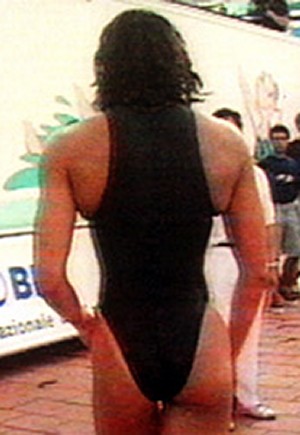
Le
Jingyi (above & below)
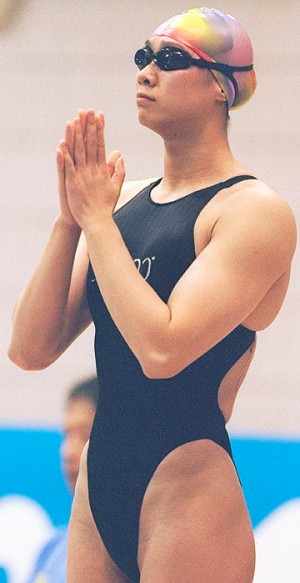 |
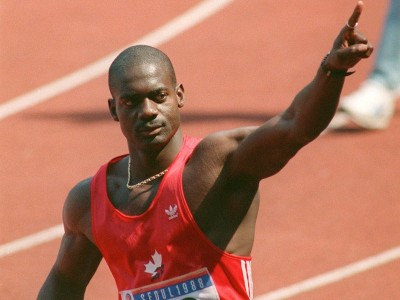 |
Ben Johnson -
Poster Boy for Drug Cheating
On an individual
basis, Ben Johnson of Canada is the most famous athlete in sports
when it comes to discussing the advantages and the dangers of using
performance-enhancing drugs. Johnson
suffered the most astounding fall from grace of any athlete in
history during the 1988 Seoul Olympics.
In 1988, Ben Johnson electrified the world
when he upset Carl Lewis, the gifted American sprinter, in
the Olympic 100 meters. Not only did Johnson handily beat
Lewis, the unquestioned superstar of the previous 1984 Olympics in
Los Angeles, it was “how” he beat Lewis that had people amazed.
Lewis
and Johnson were bitter rivals from way back. At the start,
Carl Lewis had thoroughly dominated Johnson. Lewis won Olympic
Gold in 1984 while Johnson was forced to settle for Bronze.
The race had not been close.
|
In 1985, after seven consecutive losses, Johnson finally beat Carl
Lewis. From that point on, the two men went back and forth in their
struggle for dominance. Then something strange happened in
1987. The world record for the 100 meters was 9.93. Carl
Lewis had been on the verge of breaking that record several times,
but had only a series of near-misses to show for it.
In the 1987 World
Championships, Ben Johnson set an unbelievable new world record with
9.83. Johnson had just shaved 1/10th of a second off the
record. That was an incredible achievement.
Meanwhile Carl Lewis
was beside himself with astonishment and horror at seeing his great
rival embarrass him so badly in this head to head race.
Following Johnson's
defeat of Lewis in Rome, Lewis started trying to explain away his
defeat. He first claimed that Johnson had false-started, then he
alluded to a stomach virus which had weakened him. Finally, without
naming names, Lewis said "There are a lot of people coming out of
nowhere. I don’t think they are doing it without drugs."
This was the start of
Carl Lewis’ calling on the sport of track and field to be cleaned up
in terms of the illegal use of performance-enhancing drugs. Lewis'
words didn't amount to much. While cynics noted that the
problem had been in the sport for many years, they pointed out that
it didn’t become a cause for Lewis until he was actually defeated.
Many people were fed up with the man thanks to Lewis's egotistical
attitude and lack of humility, so at the time, practically no one
rushed to defend Carl Lewis or his statements.
During a controversial
interview with the BBC, Lewis said:
There are gold
medalists at this meet who are on drugs, that [100 meters] race
will be looked at for many years, for more reasons than one.
Johnson's response was:
When Carl Lewis was
winning everything, I never said a word against him. And when
the next guy comes along and beats me, I won’t complain about
that either.
This set up the rivalry
leading into the 1988 Olympic Games.
As the Games
approached, the two men squared off at a track meet
Zurich, Switzerland on August 17.
This was their first rematch since the fateful 1987 World
Championships. Both men stood to make
$250,000 in appearance money. Not bad.
That money alone should
give us an idea of the high stakes involved for both men in being
the best. There are a lot of people in this world who might
seriously consider taking drugs for that kind of money. The
temptation must be overwhelming.
During this
much-anticipated race, Lewis, as he often did, trailed at 70 meters
and then soared to victory, eclipsing Johnson a meter from the line.
He was immediately installed in popular opinion as the favorite to
retain the Olympic gold he had won in Los Angeles in 1984.
Afterwards, Carl Lewis opened his mouth again, something he was
known for.
"The gold
medal for the Olympic 100 meters is mine," Lewis said. "I will
never again lose to Johnson."
Johnson had something of his own to say at
Zurich. It was an
eerie prophecy of sorts.
"Things are going
smoothly for me now. Losing is a possibility in Seoul. But I
will make sure that won't happen."
|
One month later at the Seoul Olympics, Ben
Johnson would indeed make Lewis eat his words. Johnson
completely humiliated his proud rival.
On September 24
1988, Johnson beat Lewis in the 100m final at the Olympics, lowering
his own 9.83 world record
down to 9.79 seconds in
the process.
Johnson would
later remark that he would have been even faster had he not raised
his hand in the air just before he finished the race.
Johnson had just
set a preposterous new world record. Most
records are broken by shaving off a single micro-second here or a
mili-second there. Johnson had trimmed an unbelievable
four-hundredths of a second off the world record.
Now that doesn’t
sound like much, but in a short race
like the 100 meters, it is very difficult for a normal human
to improve as much as Johnson did over all the people who have run
this race before him.
|
 |
At the time,
Johnson’s time was considered to be the greatest breakthrough in
track and field since Bob Beamon’s amazing long jump in Mexico
1968.
Johnson didn’t
seem fazed at all by his seemingly miraculous accomplishment. In an
interview shortly after the race, he was quoted
“I'd like to
say my name is Benjamin Sinclair Johnson Jr and this world
record will last 50 years, maybe 100.”
Do you like
irony? Johnson’s record did not last 100 years.
In fact, Johnson’s new world record
only last 3 days.
Johnson’s drug
test had just caught up with him.
Overnight the greatest breakthrough in track history was transformed
into the greatest Olympic scandal of all time. The
world was absolutely totally blown away by the enormity of the news.
In the Olympic
Doping Control Center, less than half a mile from where Johnson had
received his gold medal, Dr Park Jong-Sei had
found that one of the numbered urine samples taken from the
first four finishers contained stanozolol, a dangerous anabolic
steroid.
The number
belonged to Ben Johnson. This confirmed the suspicions of one
American trainer who had noted before the race that the Canadian's
eyes were yellow. The trainer said this was the result of his liver
working overtime processing steroids.
Confronted with
the allegations, Johnson lied through his teeth. He claimed that the
positive test surely stemmed from a spiked herbal drink the night
before the race. His competitors were trying to sabotage him.
So how did Johnson
explain his inflated deltoid muscles and jaundiced eyes?
Johnson was
subsequently stripped of his gold medal and world record and banned
from competition for two years. The disgrace of the event was a
black eye on Canadian amateur sport and pushed the drugs-in-sport
issue to the forefront like never before.
The disgraced
Johnson was stripped of his gold and forced to watch as his great
rival Carl Lewis regained his status as the world’s fastest human.
What a bitter pill to swallow. But then Johnson was used to
swallowing pills. Maybe it was time for a bitter one.
Johnson quickly
flew out of Seoul, feebly continuing to protest his innocence even
as he boarded the plane. Johnson raced at the next Olympics in
Barcelona after serving a two-year suspension but didn’t do too
well.
Taking note that
he wasn’t much of a runner without steroids, Johnson went back to
the juice. He was banned for life a year later in 1993 after he
tested positive again. At that point, any remaining doubt as to his
innocence or his honesty was long gone.
Truth be told, the
Seoul Games of 1988 were ugly in many ways. Nearly 15 years later,
it was discovered that several American track athletes tested
positive for drugs before those same Seoul Games. Allegedly among
them was Carl Lewis, the man who was awarded the gold medal after
Johnson's disqualification. Another runner under suspicion was
Florence Joyner-Griffith. She never failed a drug test, but was
judged guilty by association.
However Lewis and Flo-Jo weren’t
caught. Johnson was. He became the goat for all the rest to hide
behind.
|
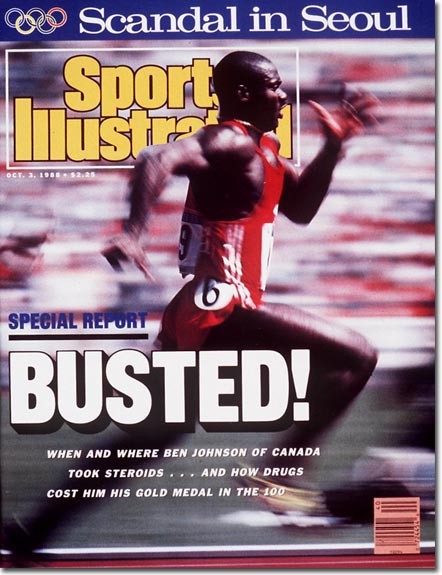 |
| |
|
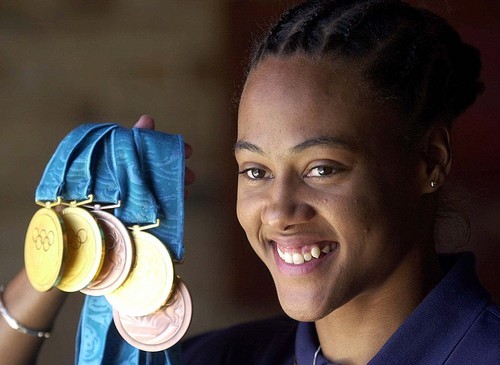 |
Marion Jones - Poster Girl
for Drug Cheating
Ben Johnson's story
was just the first. We had no way of knowing it,
but his story would be repeated many times over the next 20 years.
American sprint champions Tim Montgomery, Jerome Young and Justin Gatlin were similarly
busted. Their stories bring up an important point. While
the U.S. has not been accused of systematically doping its athletes,
there can be no doubt that many American athletes have made individual
decisions to use drugs. America has had its fair share of drug
cheats too.
Drug use in sports has become a world-wide
problem. As a result, these days, no one assumes
the winner is the winner until the drug lab confirms it. Even then,
the medals have been known to change hands years later.
The best example is the famous American
sprinter Marion Jones who was stripped of
all her medals 7 years after her victories in the 2000 Sydney
Olympics. Her story shows that
"retroactive disqualification" has begun.
|
In her prime,
Marion Jones was one of track’s first female millionaires. She
typically earned between $70,000 and $80,000 a race. On the side
she gathered at least another $1 million from race bonuses and
endorsement deals. In 2000-01, she competed in 21 international
events, including the Sydney Olympics, where she won five medals —
three of them gold.
Then, seven years
after winning a woman’s record five Olympic track and field medals
and snagging multimillion-dollar endorsement deals, Marion Jones was
broke.
The sprinter fell
heavily in debt as she tried to fight off all the attempts to strip
her of her medals and her reputation. Legal bills had plagued Jones
since 2003. That was the year suspicions of her drug use emerged
after a federal raid on BALCO, the Bay Area Laboratory
Co-Operative. This was the same raid that got famous baseball
player Barry Bonds in trouble.
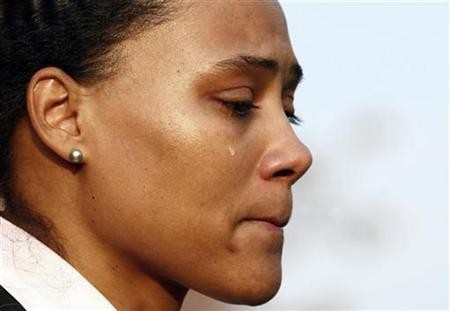 |
Jones retained
attorneys for battles on many fronts.
She needed
lawyers for her BALCO grand jury testimony, for negotiations with
the U.S. Anti-Doping Agency in her fight to avoid being banned from
competition, for the defamation lawsuit she filed against BALCO
founder Victor Conte, the man who accused her of taking
performance-enhancing drugs, and for taking on her track coach Dan
Pfaff in a breach-of-contract suit.
Jones lost every
court single fight. Her biggest problem was that she was guilty.
In the end, Jones
was stripped of her medals and forced to publicly admit that she had
used performance-enhancing drugs. Then she went to jail for six
months.
It was an incredible fall from grace…
one of the worst falls in sports history.
|
| |
|
Flo Jo - The
Poster Girl for Successful Drug Cheating
|
Who can ever forget
her? Florence Griffith
Joyner was not only the fastest woman in history,
she may have been the most beautiful too. Florence
Griffith Joyner, or "Flo Jo" as she was often
called, was the woman who combined the speed of Mercury with the body
and beauty of Venus. She was sculpted to perfection.
In 1988, Flo Jo set the
record for the fastest women's 100 meters in history at 10.49.
That record still stands today. No other woman has come close
to that.
Flo Jo owns another
record as well... one that is a bit stranger. Until Flo Jo
came along, no woman in modern history had held the world speed
record for more than five years. Most only kept it for a year.
But Flo Jo has kept the record for 24 years. That alone should
tell you there is something strange about this woman.
She is either a man, an alien
or she hides a very deep secret. Since no one in their right
mind would accuse
Flo Jo of being a man like they did Stella Walsh, let's hope that can't be the
secret. Flo Jo might be an alien, but I doubt that too. Florence Griffith
Joyner's secret is that she is considered the most prominent track star to
get away with drug cheating.
|
 |
Today thanks to
Marion Jones and Ben Johnson, we don’t believe anybody anymore. No
one seems above suspicion. After all, the stories of Jones and
Johnson turned out to be just the tip of the iceberg.
Practically every
day the sports section lists a new name of someone being accused of
success through better pharmacology. Worse, for every person that
gets caught, there are still suspicions that the winners were simply
ones that didn’t get caught.
The stakes of the
game being as high as they are and the chances of being caught small
thanks to the ability to disguise drug intake, in the past twenty
years there has been a long parade of sports champions such as Lance
Armstrong whose victories have become tainted by suspicion.
Another thing that is strange about
Flo-Jo is that she came out of
nowhere to run the three fastest women’s 100 meters in history.
Theoretically,
athletes are supposed to show early promise and steady progress.
Not Flo Jo. She had disappeared from competition
for over a year only to burst back on the scene like a fiery
comet.
Flo Jo’s personal
best before the 1988 US Trials was 10.96. This was a very good time
but well outside world record pace of 10.76.
Furthermore her best time had come five
years earlier. There was nothing in Flo Jo's
past that hinted she might someday be the fastest woman in recorded
history.
Flo Jo had given
up on athletics in 1986. She spent the best part of
the next year working as a bank clerk
during the day and styling hair in the
evenings. When she decided to return to athletics in April 1987 she
was 15 pounds overweight.
The extra weight
didn’t seem to matter. A little over four months later Flo Jo won
200m silver at the world championships in Rome. From there she just
kept on getting better. In just 15 months Flo Jo had metamorphosed
from a fat, average sprinter to a taut world-beater.
Flo Jo stunned the
world at the 1988 U.S. Olympic Trials.
Flo Jo's previous best time was 10.96
from 1983. The world record was
10.76 set by Evelyn Ashford
in 1984.
In round one,
Flo Jo posted a stunning
wind-aided 10.60. In sprints you are
supposed to improve in the hundredths… .01 or .02.
Not our Flo Jo.
Flo Jo was just
warming up. In the quarters she was timed at 10.49
(Youtube).
Flo Jo had just broken
Evelyn Ashford's world record by the
massive margin of 0.27 seconds. This was
ridiculous.
More phenomenal
times followed. The following day she won her semi-final in 10.70.
In the finals, Flo
Jo destroyed the field winning in 10.61.
In
the space of 24 hours Flo-Jo had
just run the three fastest legal women's 100m races in
history.
In so
doing, she had improved on her own previous fastest time by half a
second.
|
 |
The word
“impossible” was coined for situations like this. Flo Jo had just
done something that was considered impossible. The woman was
unbelievable!!
When the news hit
the track world, everyone was incredulous. One of the most
fascinating comments was made by none other than Ben Johnson
himself.
"There's no way Florence ran 10.49," he
said. "I just don't believe it."
Johnson was not
alone. Scores of people in the track community publicly questioned
the validity of her performance. In fact, the
level of disbelief was so high that people looked for explanations.
The consensus was that the wind at her back had made the difference.
Mind
you, there are instruments that are in place to measure the wind.
These instruments said there wasn't any wind. No matter, the
instruments must have been wrong. That's right, it must have been
the wind! No one dared mention what everyone really thought.
When Flo Jo
reached Seoul, the eyes of the entire world were upon her.
Flo Jo did not
disappoint. She delivered one the great performances in Olympic
history.
Flo-Jo won gold in
the 100m, the 200m and the 4x100m, and silver in the 4x400m.
In the 100 meters
she broke the Olympic record twice and produced a stunning
performance to win the final in a wind-assisted 10.54.
Thanks to Ben
Johnson, the Seoul Olympics were be dominated by talk of
performance-enhancing drugs. Inevitably, given the sudden and
astonishing nature of her ascent, some pointed their
fingers at Flo Jo…
but to no avail.
Griffith Joyner
took 11 different tests for performance-enhancing drugs in 1988. She
passed every single one of them.
Prince Alexandre
de Mérode, chairman of the IOC's medical commission, later said that
Joyner-Griffith had been singled out for particularly rigorous
testing in Seoul.
"Since there were rumors at the time,
we performed all possible and imaginable analyses on her. We never
found anything. There should not be the slightest suspicion."
Nevertheless, the
rumors followed Flo-Jo for the rest of her career. The reason was
simple – Joyner-Griffith had improved far too much in far too little
time. Her overnight success was enough in most people’s minds to
dismiss her victories as drug-aided.
 |
There is a very
sad and very strange footnote to the story
of Florence Joyner-Griffith.
Flo Jo retired in 1988 after her stunning run of
success. However, in 1998, just ten years
after Flo Jo's brilliant Olympic performance, this beautiful, superbly athletic woman was dead.
Florence Joyner-Griffith
had suffered an
epileptic seizure during an airline flight.
She was taken to a hospital upon landing. As she rested in the
hospital, she died in her sleep due to
asphyxiation caused by another epileptic seizure.
Flo Jo was
dead at 38.
Wrap your mind around that age. What totally healthy person
dies suddenly and mysteriously at 38?
The skeptics paused for
a brief moment of respect, then
ungallantly began to ask if past steroid use could have caused damage that
went undetected. Naturally they did an autopsy.
|
During the
autopsy, her strained heart offered only
hints that she may have had chemical help.
The Orange County coroner's
office noted that the autopsy records showed that she did not die
from drugs or banned substances and that tissue and organ tests
revealed none of the changes associated with recent steroid use. The
coroner had requested that Griffith-Joyner's body specifically be
tested for steroids,
but was informed that there was not enough urine in her bladder and
that the test could not accurately be performed on other biological
samples.
The glamorous
goddess of American track, who came, conquered and quickly vanished,
finished her brief life with a batting average of 1.000 when it came
to steroid testing.
No scientific test
ever made Florence Griffith-Joyner out to be a liar. Even on her
deathbed there was no proof.
That
didn't stop people anyone for a second. The woman's death was
so eerie that it seemed likely to suspect previous steroid use was
surely to blame.
It
was left to Brazilian middle-distance runner Joaquim Cruz to offer
the most damning criticism ever publicly raised. Cruz stated,
"The athletes are the first ones to suspect, especially the athletes
who work hard and find it really difficult to improve their times,"
says Cruz, who won Olympic gold in 1984 and silver in 1988 in the
800-meter run. "Those athletes are the ones who know who is there
competing clean and who is not."
What athletes also see is which records seem realistic and which do
not. Griffith-Joyner's sudden improvement was far beyond what
athletes consider "realistic". Evelyn Ashford's 100-meter
record of 10.76, set in 1984, was whittled to 10.49 in Indianapolis
in 1988. The margin of difference was more than double any previous
improvement. Nor has anyone even remotely approached those
speeds since.
After 24 years without a serious challenge, Griffith-Joyner's
records in the 100 and 200 meter dashes have joined the ranks of the
eternally suspect.
Direct evidence of doping has never been presented against
Griffith-Joyner, but suspicions began at the start of the 1988
season, when she returned after a long layoff. She had never won a
world championship, but now the runners were supposed to accept that
a woman with nearly two years of layoff was suddenly the fastest
woman in the world. Her body had also morphed from slender to
ripped.
During the Olympics that year, Cruz was asked what he thought about
Ben Johnson's positive steroid test. Cruz answered, but also offered
opinions on other competitors, thereby breaking a universal
athletes' code to not name names. In doing so, he also made it all
right for journalists and critics to speculate about who might be
doping.
"Florence, in 1984,
you could see an extremely feminine person, but today she looks
more like a man than a woman,"
Cruz said in the interview.
"And Jackie Joyner (Flo Jo's sister in law) herself, she
looks like a gorilla, so these people, they must be doing something
that isn't normal to gain all these muscles."
When Cruz
saw his name in print next to these words, his first reaction was to deny that he made the comments.
He also
apologized to Joyner-Kersee in person.
However, when a tape of the
comments surfaced, Cruz was openly vilified. There was no more
denying what he had said.
Cruz, who today coaches
high school and works with a group of elite runners near Los
Angeles, says he was scorned by the fans, but he was never ostracized by athletes for what he said.
"In the (Olympic) village I became the hero," Cruz says.
"Everybody
said, 'Yeah Cruz! Keep up the good work.'"
The
reputation of Flo Jo took a bigger hit a year later when sprinter Darrell
Robinson, in a paid interview with a German magazine, said he had
given her human growth hormone.
Griffith-Joyner denied it, and when they both
appeared on the "Today" show, she said, "Darrell, you are a
compulsive, crazy, lying lunatic!"
|
 |
It is
likely the
dark cloud of circumstantial evidence will follow
the story of
Florence Griffith-Joyner
for
eternity.
But
Florence Griffith-Joyner is certainly not the only one with a cloud
hanging over her reputation.
Is Lance Armstrong
guilty? Maybe.
Is Roger Clemens
guilty? Maybe.
Is
Barry Bonds guilty?
Maybe.
I don’t know the
answer for any of these people, but I am suspicious.
Thanks mostly to
the story of Flo Jo, whenever someone comes out of nowhere to be
wonderful, I shrug my shoulders and idly wonder if they will get
caught or not. Or "when" they will be
caught.
Thanks to lessons
learned from Marion Jones and Ben Johnson, and yes, sad to say,
even Flo Jo, my attitude is cynical.
When it comes to sports these days, if it’s too good
to be true, then it probably isn’t.
In
retrospect, Flo Jo was the woman straight out of Greek Mythology.
She
had the speed of Mercury, the beauty of Aphrodite... and the life
script of Achilles.
Achilles, of course, was half human, half god. For the brief
time he was alive, Achilles was the most feared warrior on earth.
But thanks to his unprotected heel, he had that one single fatal
flaw. Achilles conquered everything in sight and experienced
intense glory... only to suddenly die at a young age from the
poisoned arrow.
Who
is to say that Flo Jo didn't die of a similar poisoned arrow?
She
most likely made a dangerous life choice which later struck her down
at an age much too young to make any sense. Is it better to
live a long and comfortable life or is it better to reach for the
glory and risk an early death?
Florence Griffith-Joyner was our modern day Achilles.
|
 |
Final Thoughts
about the Drug Problem
The
mysterious death of Florence Griffith-Joyner is very important
because many people - including medical professionals - openly
suggested her sudden death could be related to past steroid use.
Whatever the real cause of Flo Jo's death, it underscored the
dangers of steroid use. There can be no doubt steroid use carries a
great risk of health consequences.
The
truth is that little is known about the long term effects of steroid
use.
However, the early reports are in and the picture is not pretty.
The former athletes of East Germany are reporting all sorts of
health and psychological problems directly attributed to steroid use
20 to 30 years ago.
Seized documents of the East German secret
police Stasi revealed
that as many as 10,000 East German athletes were involved in
the state-sponsored attempt to build a
country of 16 million into a sports power rivaling the United States
and the Soviet Union.
Today an estimated 500 to 2,000 former
East German athletes are believed to be experiencing significant
health problems associated with steroids, including liver tumors,
heart disease, testicular and breast cancer, gynecological problems,
infertility, depression and eating disorders. Some
female athletes have reported miscarriages and have had children
born with deformities like club feet.
Given this situation, what person in their right
mind would turn to drugs?
Sad
to say, even given the knowledge, quite a few athletes are more than
willing to make the Devil's Bargain. Given that masking
techniques appear to be running ahead of detection techniques, the
temptation to achieve glory and financial gain TODAY seems to
outweigh the well-known risks somewhere in the distant FUTURE.
Some
people say, "Well, since you can't catch all of them and lots of
cheaters are winning against the people who play by the rules, why
not just make steroid use legal? Level the playing field for
everyone. After all, that's how they solved the amateur versus
professional issue. If those idiot athletes want to kill
themselves, that's their choice."
Having given this some thought, I disagree.
First, records are important. It isn't fair to the athletes
who competed in the pre-drug era to have their performances erased
or compared to these clearly-tainted modern day results.
However, this reason is trivial compared to the health risks the
athletes would likely face.
If we
make steroid use legal, that would not only give athletes permission
to take enormous health risks, it would almost force them to
participate or have no hope of winning. Now practically every
athlete in the world would be forced to begin using drugs to stay
even with their peers or simply retire from their sport.
The
counter-argument to that is that most people with a brain wouldn't
dream of deliberately hurting themselves.
Don't
be ridiculous. If taking drugs is the only way to climb to the top
of their sport, many will choose to do so. Take hockey players
for example.
In the
National Hockey League, players were continually suffering gruesome
injuries to their face. Every season, dozens of players would
routinely lose eyes, teeth, and facial bones to high sticks and
fast-moving pucks. The danger was getting so great the league
asked the players to voluntarily begin wearing helmets. Some
complied, but most of the players refused. They didn't want to
do anything that would reduce their peripheral vision. Finally
the league had to put its foot down and "insist" that the players
wear helmets for their own good. Once it became mandatory, the
athletes gave in.
Given
this lesson, we know that since athletes are born risk-takers, we
don't dare even dream of legalizing the drugs.
The only way to stop drug use in sports is to
keep them illegal, keep improving the tests and, more important than
anything, increase the penalties. Not only take away all
medals and ban athletes for life on the first or second offense,
also make them pay fines.
Moreover, keep freezing that blood and let the athletes understand
that their samples will be tested again with the newer methods every
few years. Since that is how most of the drug cheats are being
caught these days - retroactively - the paranoia might actually make
them think twice. Imagine how Lance Armstrong feels knowing
his entire career could be wiped out if just the right test comes
along.
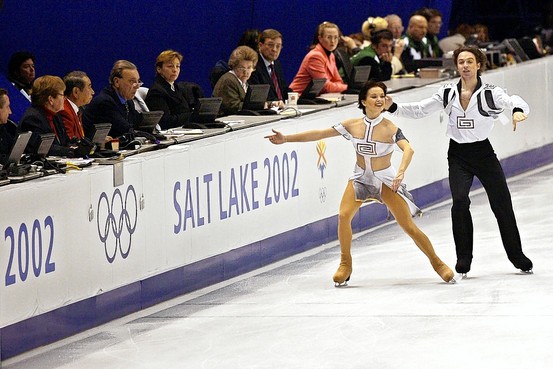 |
WHY NOT JUST BRIBE THE JUDGE?
Unfortunately,
there are many Olympic sports where the winner is determined by
other human beings. Any sport that requires judges to determine the
winner is ripe for controversy. This “subjective” element in highly
competitive sports such as gymnastics, boxing, diving, and figure
skating routinely brings out the temper in many observers. I might
add I dislike dance competitions for the same reason. It is very
difficult to accept some of the decisions.
But there isn’t
much anyone can do about it. How can anyone effectively dispute
someone's subjective opinion? They were
hired to call it as they see it. The decision of the judges is
final.
That doesn’t keep
people from trying. Hardly. The announcers are the worst. They
routinely question any judge’s decision that hurts a hometown hero.
That sort of negativity may be bad for the viewer’s blood pressure,
but since it improves ratings, blaming the judges becomes a national
pastime during the Olympics.
|
Some of the
decisions are so glaringly bad that people actually wonder if the
judges are crooked. For example, to this day, I still think
something underhanded took place
at that bizarre 1972 Russia-USA
basketball game.
Although the
secret of what happened behind the scenes at
the 1972
basketball game has never been revealed,
here are two famous controversies involving Olympic judges that
prove shady dealings have indeed taken place in the past.
Roy Jones
When Roy Jones
lost the boxing gold medal at Seoul in 1988, his loss was considered
the worst example of crooked judges in Olympic history. 2 judges
voted Jones the winner of his match, 3 judges voted Jones the
loser. Only one problem – every neutral observer in the world
thought Jones had won by a wide margin.
Jones had
dominated his weight class for the entire Olympics. He won his
first match by knockout. He won his next two matches 5-0 by the
vote of the judges. He won the next one 4-1.
The final match
against South Korean Park Si-Hun wasn’t even close. Jones won in a
rout. Jones was so unthreatened he barely bothered to raise his
guard. He landed 86 punches to Park's 32. The South Korean took
two standing eight counts and was twice warned by the referee.
NBC's Count-A-Punch recorder scored the rounds 20-3, 30-15 and 36-14
in Jones's favor. It was an utterly one-sided affair.
And yet Jones
lost.
In a highly
controversial 3-2 judge's decision, South Korean boxer Park Si-Hun
was given the nod over American Roy Jones. Allegedly, Park himself
was so surprised that he apologized to Jones afterward.
The
verdict sparked a world outrage. It didn’t help that
Park was from the host country. Something was very wrong here.
Hot accusations were leveled at the judges who had voted against Roy
Jones.
|
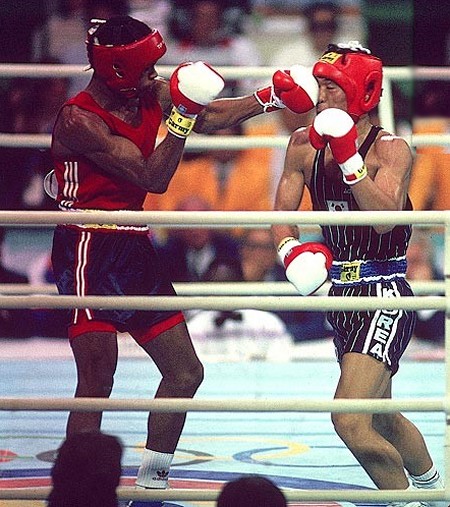 |
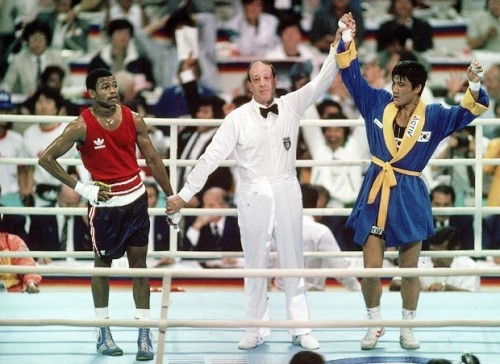 |
One judge shortly
thereafter admitted the decision was a mistake. What a joke! The
judge said, “I felt bad that this man (Park) had been so badly
defeated in his home country. I knew the other four judges would
vote for Jones, so I gave a sympathy vote to the South Korean to
save face”.
What a crock.
That story is BS-speak for “someone gave me money to throw the
match”.
Eventually, all
three judges voting against Jones were suspended.
Meanwhile,
everyone was so disgusted by the result that Roy Jones was named the
outstanding boxer of the tournament.
However, the scandal was whitewashed
just like the 1972 basketball result. The official IOC
investigation in 1997 found no wrongdoing. To this day, the IOC
still officially stands by the decision.
|
| |
|
The Canadian
Skaters
A similar
judging controversy occurred at the 2002 Olympic Figure Skating Finals in Salt Lake.
When competition ended in
the pairs skating event at the Salt Lake
City Olympics, fans in the audience and around the world thought
they knew who'd won. Canadians Jamie Sale and David Pelletier
circled the ice triumphantly, while fans chanted "Six! Six!"
demanding a perfect score for the talented duo's
magnificent performance.
Those fans were silenced,
however, by scores that handed the gold medal to the Russian team of
Elena Berezhnaya and Anton Sikharulidze, even though Sikharulidze
had failed to appropriately land one of his double-axels.
Jamie Salé and
David Pelletier's second-place finish in the 2002 Winter Olympic
pairs event shocked fans and experts around the world. The
announcers on TV had gasped noticeably when the ordinals popped up
on the arena scoreboard. Their startled reaction was so unfeigned
that the world instantly sat up and took notice.
The
headlines said it all: "Canadian Figure Skaters Robbed!"
|
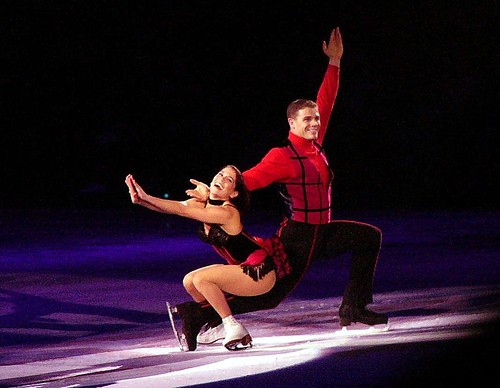 |
As the media asked
every trained observer at Salt Lake for their opinion, the consensus
was positive that Sale and Pelletier had cleanly won the Gold.
Something was wrong here.
With so many
suspicions raised, an investigation was initiated.
The
world of figure skating hit an all-time low when
a French judge admitted her role in a conspiracy with her
Russian judge counterparts that had cheated Salé and Pelletier out of their
gold medal.
The saga that
unraveled in the subsequent days was stunning. The
new developments
suggested a vote-swapping deal between Russian and French
officials. This particular
scandal read like a tale ripped
from the pages of a pulp novel. It involved international intrigue
and possible corruption. The controversy was ratcheted even higher when
investigations pointed to a reputed Russian mobster at the heart of
the scandal.
The deal was
simple – if the French judge voted for their guys, the Russians
would vote for her guys.
Figure skating is
only a ‘sport’ by the loosest definition of the word because the
judges have far too much say-so in the outcome. Their sometimes
strange conclusions make the results completely subjective and very
much open to debate. The purists contend that all sports should be
as conclusive as possible. For example, it is easy to see that one
runner ran faster than the other and that Team A beat Team B, etc.
To have a sport
where one competitor “impresses” the judges slightly more than the
other person offers up very unsatisfying results.
That said, it
seems to be human nature to want to know who the winners are, so
judging seems to be the only answer.
Figure skating and
Russia have gone hand in hand as long as there have been Winter
Olympics. Russia takes great pride in its skating prowess. The
Russians had dominated the event of pairs figure skating for years.
Unfortunately, going into the 2002 Winter Games, the Russians knew
the Canadian team was the heavy favorite. The only way their guys
would win would be through skullduggery. So the backroom deal was
made.
Unfortunately, the
Canadian figure skating pairs team skated a flawless program.
Making things worse, the Russian pair made an obvious technical
error during their program.
It looked for sure
like the Russians would finally lose this event they had owned for
years.
However, when the
results were revealed, the Russians had won against all odds. The
judges from Russia, the People’s Republic of China, Poland, Ukraine,
and France had placed the Russians first.
Judges from the
United States, Canada, Germany, and Japan gave the event to the
Canadians.
All eyes were on
France. France was the obvious odd ball in that first group.
The French judge
Marie Reine Le Gougne broke down immediately under questioning. She
claimed that the French skating federation had pressured her to vote
for the Russians regardless of what actually happened.
A
Russian mobster named Alimzhan Tokhtakhounov was blamed for
masterminding the fix.
This tit for tat
agreement would guarantee votes coming from the Russians for the
French ice dancing competitors competing a few days later.
The IOC went ahead
and upgraded the Canadians to a gold medal. However, the Russians
were allowed to keep their gold medal. This was a very curious
compromise given what had been discovered. Shouldn’t the Russians
be punished for their involvement in this scandal?
Alas, the
whitewash was in. This strange decision proved that cheaters do
indeed win.
The controversy
rocked the public's confidence and led the
sport to clean up its act. The International Skating Union developed
a new judging system that seemed to be a definite improvement.
Nevertheless, whether it’s boxing,
figure skating, gymnastics, or even a peculiar sport like
synchronized swimming, as long as the human element is involved in
the determining the outcome, there will always be controversy as
well as the potential for cheating.
|
 |
| |
|
TONYA
HARDING, THE UNDISPUTED GOLD MEDAL WINNER FOR OLYMPIC CHEATING
|
 |
The
story of Tonya Harding
offers a disturbing peek into the darkest regions
of the human soul. It shows
what can happen when someone
who isn't wired together particularly well in the first place
suffers too many close losses in a brief period of time.
Just
because a competitor has physical gifts doesn't guarantee they have
the psychological make-up necessary to succeed at the highest levels
of sport. Learning to deal with the pain of losing is just as
much a part of the game as learning how to win.
Not
everyone has the strength to deal with the disappointment of a
narrow loss
after putting their heart and soul into the dream of winning. In
the Olympics, for every winner, there isn't just one loser, there
are often a dozen or so people who thought they had a legitimate chance of
winning. There are bound to be some who don't handle losing
very well. They are tempted to do something unethical.
Like the others, Tonya
Harding cheated because she wanted to win.
That much is clear. Cheaters abound in
all Olympic sports.
Where her story deviated from the norm was her decision to actually hurt
a rival. Until Harding came along, that was unheard of.
|
Only in football and perhaps hockey can I think of a sport where
some people attempt to deliberately hurt their opponents. But even in
football, there is a code that at least limits the aggression to the playing
field. I might add the players wear helmets and pads.
Tonya
Harding's willingness to sanction a
“hit” on Nancy Kerrigan
remains the single most egregious example of poor sportsmanship in sports
history. Not only had Kerrigan had
done nothing to deserve such treatment, it
never seemed to cross Harding’s mind that if the
goon she hired made a bad mistake, any damage might ruin
Kerrigan’s career permanently. Given
this risk to Kerrigan, Harding’s callousness was beyond
reprehensible.
The crazy thing
is, Tonya Harding had real talent. She didn’t have to stoop this
low. Harding should have been able to beat her hated nemesis
straight up. After all, Harding was a former US figure skating
champion and only the second woman to ever land a triple axel in
competition. The insiders said Harding had more natural ability
than Nancy Kerrigan. All Harding had to do was train more
consistently and get her head together.
But once Harding
decided to cripple her closest opponent by smashing her in the knee
with a police baton, she crossed the line. Poor Mistreated Tonya
would never again be known her ability.
 |
1991 –
Almost
on Top of the World
Once upon a time,
Tonya Harding had stood tall on the world platform. In 1991 Harding
became the US National figure skating champion. She
had beaten both
Kristi Yamaguchi and Nancy Kerrigan to take first place.
Tonya Harding was officially America's best
female figure skater.
Harding didn’t
know it at the time, but that would be the high water mark. From
this point on, Harding began a slow descent that drove her
over the edge with frustration.
The fall didn’t
happen all at once. In fact, Harding followed her US victory
with a strong showing at the 1991 World Championships.
She finished in
second place.
You would think
she was happy. After all, finishing one spot behind was her
contemporary Nancy Kerrigan. But Harding didn’t care about Kerrigan
at that point.
Tonya Harding was
furious because she had narrowly missed becoming the World
Champion. Harding could not believe that Kristi
Yamaguchi had passed her to win the World title. How could Harding
let Yamaguchi slip ahead of her to win the top prize?
For crying out loud, Harding had
just beaten this woman one month earlier back in the USA!
Harding had barely missed becoming the best
skater in the world. It was that close. The anguish of
losing to someone she should have beaten was almost more than
Harding could bear.
|
1992 – A series
of near misses
Harding slipped
another notch in 1992. It started with the 1992 US Nationals. In
this event, Kristi Yamaguchi replaced Harding as the US Champion. Even
more galling, Nancy Kerrigan finished second. Harding had slipped all the
way to third.
Both rivals had passed her. No matter. Harding
was sure this was just an aberration. She would beat both of them
at the upcoming 1992 Winter Olympics in Albertville. No such luck.
It was a terrific showing for the Americans. Not only did Kristi
Yamaguchi win the women’s figure skating crown
and Nancy Kerrigan took the Bronze Medal. Midori Ito of
Japan finished second.
So where was
Harding? Harding was beside herself with
frustration. Harding had been in front of Kerrigan for most
of the competition only to see her rival edge her out for the Bronze
on the final round. Harding finished fourth. She was forced to
watch in the shadows as Yamaguchi and Kerrigan climbed the pedestals
to receive their medals. Harding could not believe that Kerrigan
had just nosed her out for the final medal.
She was consumed with despair.
First Yamaguchi
had passed her. Now Kerrigan had passed her. This feeling was
awful because Harding knew she was a better skater than Kerrigan.
Harding fumed with bitterness at narrowly missing winning an
Olympic medal.
This anger became the prime source of her resentment towards the
world in general and Kerrigan in particular.
The next
humiliation came one month later. In the 1992 World Figure Skating
Championships, Yamaguchi reigned supreme again. Nancy Kerrigan
skated beautifully to capture Second place. Harding slipped all the
way to sixth place. Now her confidence was really shaken.
|
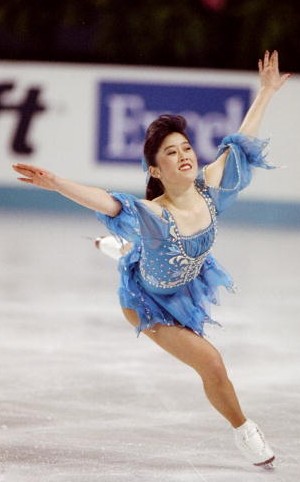 |
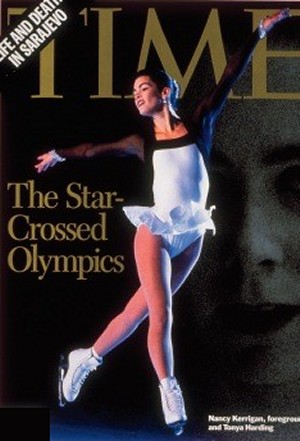 |
1993 -
Another Difficult Year
After Kristi
Yamaguchi won all three major championships in 1992, she decided to
go out on top and turn professional. This left the field open for
Kerrigan and Harding to fight it out for the top spot.
This is when
Harding began to obsess on Kerrigan. She was worried because it
seemed like she and Kerrigan were going in opposite directions.
Kerrigan had finished 2nd, 3rd, and 2nd in last
year's major competitions. Harding had finished 3rd, 4th, and
6th. This was unacceptable. Harding vowed that
in 1993 she would catch Kerrigan
and regain her spot as America's top figure skater.
Easier said than
done. Unfortunately, it was Nancy Kerrigan who won the 1993 US
National Women’s Figure Skating Championship. Harding finished
fourth. Not even close. The harder she tried, the worse she did.
Harding was fit to be tied.
To everyone's surprise, Kerrigan's
run of strong finishes was broken when she slipped
to 5th place in the 1993 World Championships.
Harding should have been able to take advantage, but Harding
did not even appear. In the middle of a divorce, Harding was a
mess. She had failed to even qualify for the Worlds team. 1993 had
been no better than 1992. In fact, 1993 was
worse.
Harding began to
fixate on the upcoming 1994 Winter Olympics. This would be her last
best chance at world glory.
|
1994
Up till now, the
Winter and Summer Olympics had always been held in the same year.
However, some
marketing genius
had come up with the clever idea to split the Winter and Summer Oympics two years apart. Better for TV ratings! Even though the
Winter Olympics had just been held in 1992, now there was another
Winter Olympics looming just around the corner in 1994.
The
sports experts had placed Nancy Kerrigan and Tonya Harding among the
favorites to win the Gold Medal at the 1994 Lillehammer Winter
Olympics. Kerrigan was a slight favorite over Harding, but Harding
was given a strong fighting chance.
Unfortunately,
behind the scenes, both women were
consumed with worry.
Harding’s confidence was shot.
When Kerrigan had won the recent 1993 U.S. Championships, Harding
began to despair of catching her. What Harding didn’t know was that
Kerrigan was just as rattled as Harding was. Kerrigan’s 5th place
finish at the Worlds had turned her into a basket case as well. This
is a sport where nerves can destroy a year’s work with just one
mistake.
Harding knew her
chances were shaky at best. She could not bear the thought of losing
to Kerrigan again, especially not at the Olympics. Overwhelmed with
Gold Fever, Harding was desperate.
The idea when you
are the underdog is to outwork your opponent. The problem was that
Harding could see Kerrigan was training just as hard as she was.
What about Plan B? What could Harding do to gain an edge?
That’s when the
idea came to Harding. Why not cripple Kerrigan? Why not rough her
up enough so that Kerrigan couldn’t compete in the upcoming
Olympics? Tough break for Kerrigan, but she was younger.
Nancy
would have other chances. With Kerrigan out of the way, that would
leave the field wide open for Harding. Harding ran it past Jeff Gillooly, her
slimy ex-husband. Gillooly signed on.
Rivals
You could not
have asked for two
more different women than Nancy Kerrigan and Tonya Harding.
Harding was a raw athlete
who came from the wrong side of the tracks. Harding had more natural
ability, but far less training. Harding resented Kerrigan because she
believed Kerrigan had gotten all the breaks in the life.
Harding believed if she had gotten the same kind coaching as
Kerrigan, she would have been unbeatable.
Harding
also knew she was
plain. She wasn’t happy about that either. Kerrigan on the other
hand was a stately, beautiful young woman. When you put the two of
them on ice together, all eyes naturally went to Kerrigan and
Harding knew it.
Kerrigan was your
archetypal disciplined hard worker who got the most out what talent
she had. She was a polished skater who was more ‘aristocrat’ than
‘athlete’. What Kerrigan lacked in talent she made up for with
poise and constant training.
|
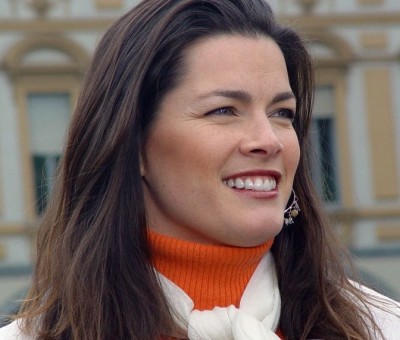 |
Despite her aura of sophistication, Nancy Kerrigan was no
blue blood. Kerrigan had earned every break she had ever gotten.
No one handed her anything. Her parents were decidedly middle class
folks who had dedicated themselves to their talented daughter’s
career. In this sense, Kerrigan clearly had a far better support
system than Harding could ever dream of.
Unfortunately, Kerrigan had a
fatal flaw of her own. She often let her nerves get the best of her in key
situations. Kerrigan was just as worried about Harding beating her
as Harding was about Kerrigan. Kerrigan's
solution was to train as hard as she could.
That
should have been Harding's decision too.
However Tonya Harding
simply wasn’t thinking straight. Harding’s bad attitude had her
mind way out of kilter. She wanted to win at all costs. Harding
was a trailer park kid from a broken home.
She had a big chip on her
shoulder. Why was everyone out to get her?
It was time for her to catch a
break. Harding was hungry for glory. She wanted fame and
success to the point of desperation.
These upcoming Olympics
were her best chance at fame. Now only one person – Kerrigan –
stood in her way to become the most famous
figure skater in the world.
What is crazy about
Harding’s thinking is that Kerrigan was certainly not her only
threat for the Gold Medal. One
thing that people forget is that Kerrigan was hardly a shoo-in for
the Gold Medal. One year before, Oksana Baiul of the Ukraine,
Surya Bonaly of France, Chen Lu of China, and Yuka Sato of Japan had
all finished ahead of Kerrigan at the Worlds in 1993.
No one has ever
explained what good Harding believed it would serve to eliminate
Kerrigan when those other four women were just as much threats to
Harding in their own right. Was she going
to whack them too when the time came?
The U.S. National Figure
Skating Championships were held in January
of 1994. The first two finishers would
make the Olympic squad. Kerrigan was the defending champion, but
Harding was getting a lot of attention.
The competition was touted as a preview of the gold-medal battle at
the Lillehammer Olympics one month later.
How could Tonya Harding
beat her nemesis Nancy Kerrigan?
She and her ex-husband
Jeff Gillooly decided the easiest thing to do would be to injure
Kerrigan. Only one problem… Gillooly was too easy to recognize.
Plus he needed an alibi.
Gillooly decided he
needed a hitman. Literally. He found a low-life buddy named Shane
Stuart who was willing to do the job.
On January 6, 1994, as
Kerrigan left the ice after practice, Stuart came out of nowhere to
club Kerrigan in the knee with a collapsible police baton. As
Kerrigan screamed in pain, Stuart ran away and escaped.
Kerrigan collapsed and
began to sob profusely. The blow hurt terribly, but Kerrigan also
cried because she thought her Olympic dream was over. She wailed
"Why, why, why?"
Incredibly, the entire
incident was caught on camera. Kerrigan could be seen falling down
and grabbing her knee. This dramatic video became a
round-the-clock staple of nearly every news organization in the
world for days after the attack.
Listening to the young
girl’s plaintive wail made the
entire nation...
make that the entire world... feel extreme sympathy.
|
 |
Kerrigan's injury forced
her to withdraw from the U.S. Championships. However, the officials
agreed that Kerrigan merited one of the spots on the Olympic team if
she was able to recover.
Meanwhile, Harding’s plan
paid off with immediate
dividends. With Kerrigan
eliminated, Harding went on to win the 1994
US Nationals. Tonya was back on top.
She would definitely be going to the
Olympics.
But what about
Kerrigan? Kerrigan’s life changed dramatically in the month during
her recovery. Amazingly, Kerrigan recovered quickly from her knee
injury and resumed her intensive training. The ordeal had
seemingly snapped her back into the right frame of mind.
She practiced by doing complete
back-to-back double run-throughs of her programs. In
so doing, Kerrigan magically regained much of her confidence
in her ability to compete under pressure.
 |
Physically Kerrigan
wasn’t 100%, but everyone could see she was able to skate well
enough to potentially medal. The US Skating
Association went ahead and gave the spot
they were saving to Kerrigan. Now Kerrigan was on the Olympic team
as well.
While
Kerrigan's star was rising in the days leading up
Lillehammer, Harding found herself in a heap of trouble.
Harding was in the middle of a criminal
investigation into the attack on Kerrigan.
The plot had unraveled
almost immediately. On the same day as
the attack, the police had received an
anonymous tip that pointed them straight to Jeff Gillooly.
This
led to a bizarre situation. Kerrigan was fully aware that
Harding was behind her attack. However, Kerrigan had no choice
but to share the ice with the same woman who had tried to hurt her.
This scenario was incredibly stressful for both women, but the press
loved it.
The
media covered Nancy Kerrigan non-stop. Kerrigan had become the
biggest star in the world. Thanks to
the world-wide outpouring of sympathy, the fame Kerrigan had
acquired from the attack led to further professional opportunities.
It was reported that Nancy Kerrigan had signed contracts for $9.5
million before the Olympic competition had even begun. Talk about
turning lemons into lemonade!
Meanwhile, Harding became the most hated woman in the world.
It was a sportswriter's
dream when Tonya's trailer park world collided with the artsy
aesthetics of figure skating and the classy Kerrigan.
“The Whack Heard Around
The World," as it was known in the headlines, was the beginning of
Harding's tabloid notoriety.
|
It was a sensational
story. For the next month, practically every day the sports section
screamed with more putrid details about the attack.
Harding's behavior was truly
disgusting.
In the build-up to
Lillehammer, the Kerrigan-Harding rivalry was followed
intently around the world. One wag pointed out this was the best
ongoing soap opera in Olympic history.
Oddly enough, Harding seemed
to revel in all the attention. In a twisted way, the notoriety
seemed to satisfy the woman's unhealthy thirst for stardom.
The US Olympic
Committee tried to bar Harding from competition, but backed down
when she threatened legal action.
Thanks in large part to threats from her excellent attorney, Harding
was allowed to compete in Lillehammer.
However, Harding’s bravura
could only take her so far. Understandably upset at the catcalls
and the humiliation from being labeled the most hated woman in the word, Harding skated
poorly and finished eighth. Not that any of the
judges felt the slightest bit sorry for her…
The good news was
that Nancy Kerrigan recovered enough to at least win the
silver medal behind the Ukraine’s
gifted Oksana Baiul.
Everyone had
hoped Kerrigan would win, but Baiul was clearly better.
Oh well. It was okay. Win or
lose, Nancy Kerrigan was America's newest princess.
She headed to Disneyland, made lots of money, soon became
engaged, had babies and lived happily ever after.
|
 |
|
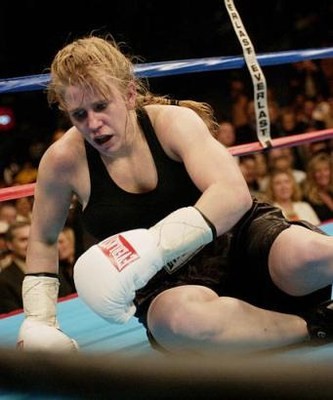 |
On the
other hand, once the Olympics ended, Harding’s world came
crashing down on her. She admitted in a plea bargain that she
had been
involved with ex-husband Jeff Gillooly in the
scheme to injure Kerrigan right from the start.
By coming clean, Harding was at least able to avoid jail time. Gillooly wasn’t so
lucky. He got two years in prison.
Harding was subsequently stripped of her
national title and banned from amateur skating.
Harding had lost the only thing she had ever
cared about. It was also the only thing she was good at.
Harding began a
rapid descent into the abyss. Barred from skating, she had nothing
else with which to support herself other than her bad reputation.
At this point, Harding reverted to the Trailer Park lifestyle. She
turned into a complete hillbilly. Never a pretty girl to begin
with, Harding gained a great deal weight and wore a perpetual
frown. She competed in female boxing and went on some wild drinking
sprees. To make things worse, she released a sex tape that was so
bad it was rumored to cause blindness.
In this bizarre tale of two women, it
is illuminating to see how badly Harding’s plan backfired on her.
What a bunch of misfits! Not only did the incompetent hitman fail
to inflict any serious injury on Kerrigan, someone in her camp
turned her in to the cops almost immediately.
Maybe it really is
true that cheaters never win, but
certainly not cheaters as pathetic as Tonya Harding. Without a
doubt, her final epitaph will point out that Harding is the all-time
icon for poor sportsmanship.
What a thing to be remembered for.
|
| |
|
The Brighter Side of the Olympics
 |
For all the horrible stories I have
listed,
please remember that the Olympics can
also be incredibly inspiring.
My favorite
Olympic sports stories are about people like Jesse Jones, a black
man who shattered Hitler’s myth of Aryan supremacy at the 1936
Berlin Games by winning the 100 meters.
Another great story was
watching little Kerri Strug with her badly-swollen sprained ankle
nail a vault to give the Americans a razor-thin victory over the
Russians in 1996 Atlanta. Such courage to
overcome certain pain and still perform!!
|
|
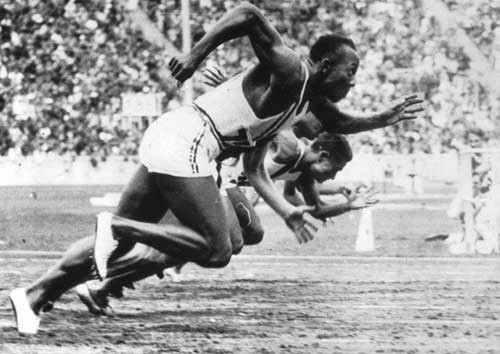 |
| |
|
Abebe Bikila
However my
favorite Olympic story is about an unknown runner
from Ethiopia named Abebe
Bikila. Bikila was a
last-minute replacement in the marathon for an injured teammate in
the 1960 Rome Olympics.
Bikila
had absolutely no presence on the world stage.
No one had ever heard of this
guy before. In the days leading up to the
race, out of nowhere a rumor emerged that Bikila's unofficial
personal best for the marathon was even better than the world
record. However this was widely dismissed as impossible blather.
How ridiculous! Who were these Africans trying to fool?
The rumor turned
out to be true. Bikila would win the race,
shatter the Olympic record and set a
new world best. However, what Bikila is most famous for is getting
up on the podium without shoes. That’s when everyone in the stadium
realized that Bikila had run the entire 26 miles barefooted on the
burning hot, frequently rutted concrete. He had done this because his
delegation was too poor to find him proper equipment.
The entire
world was incredulous. How on earth did
this man set a world record for running a 26 mile race barefooted?
The pain must have been unbearable!
Bikila’s victory
was the first hint of things to come. It marked the rise and future
dominance of East African middle- and long-distance runners.
|
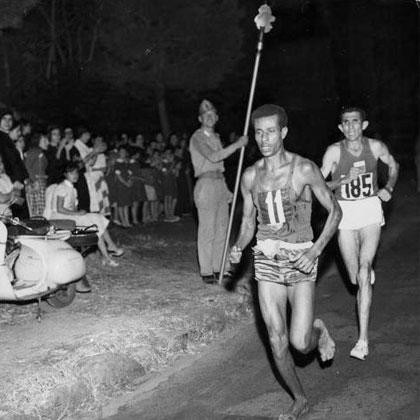 |
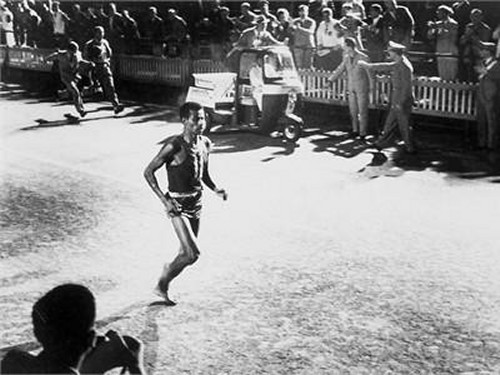 |
However, what I
liked bestwas the
powerful symbolism. This was a
huge upset victory for the little guy against tyranny and
prejudice.
Bikila’s victory came in Italy, the land that had
cruelly oppressed the Ethiopian people for centuries.
Back home, Bikila became an instant national hero. He had
embarrassed the Italians in much the same way that Jesse Owens had
embarrassed Hitler and the German 'supermen'.
Even
more interesting, Bikila’s victory came
in the presence of the all-white South African team back in the days
of apartheid. What do you suppose went
through their bigoted, hate-filled minds as they watched the first black African to ever
win a gold medal in Olympic history cross the finish line?
In
world-record time no less! And barefoot too...
Bikila’s victory came against the vastly better
funded and better-equipped Soviet, U.S. and European athletes.
He beat the greatest sports machines on the planet all by himself.
No coaches, no equipment, no special diet, and certainly no scientific training
regimen. It was just Bikila against the world.
|
Bikila’s victory
was a victory not just for Ethiopia, but the
entire world. Bikila reminded us why we
watch the Olympics – to see what the human heart and mind can
accomplish when given the chance, to see how an
underdog can still succeed against all odds.
This has been a story about cheating and poor
sportsmanship. It is very sad
when you can’t trust your sports heroes. After all, sports heroes
are supposed to be gifted people who we can admire and draw
inspiration from. A hero is supposed to be an athlete who climbs to
the top thanks to hard work, courage and ability, not because they
have the best drug doctors helping them gain that precious edge.
If you get a
chance to watch the next Olympics, maybe someone like Abebe Bikila will
step forward to inspire us all. I certainly hope so. It would be
nice to see the biggest story at the London
Olympics is not about a
cheater, a scandal or a terrorist, but rather
about an actual
hero.
Thank
you for reading.
Rick Archer
July 2012
rick@ssqq.com
|